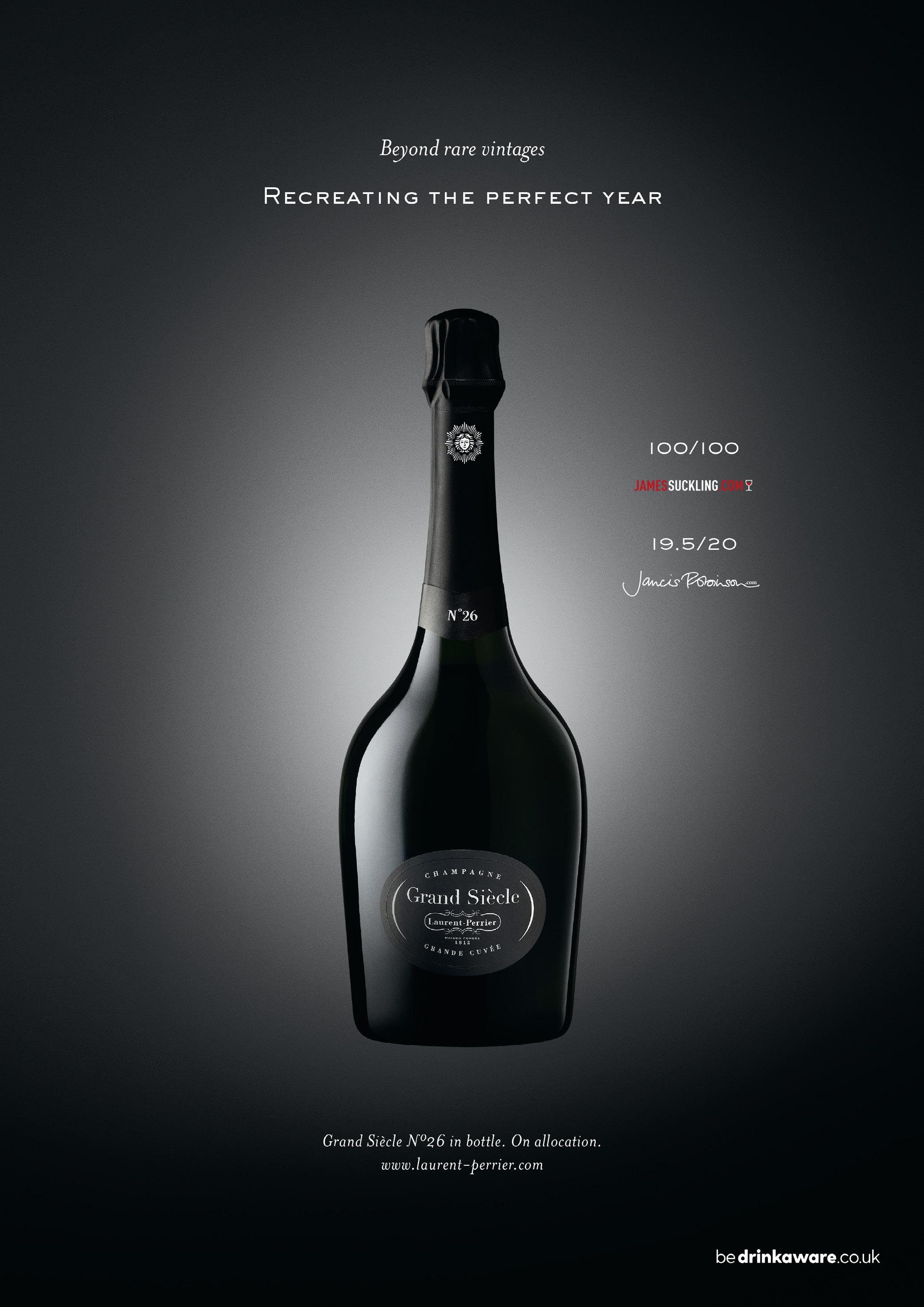THE WINE MERCHANT.
An independent magazine for independent retailers Issue 136, June 2024



Election candidates must be told that indies will go under if excise scheme goes ahead – and that the solution is simple
Independent merchants are being urged to make a final attempt to persuade politicians not to proceed with next year’s duty reforms, which are widely expected to cause mayhem for importers and retailers.
With the general election campaign underway, the Wine & Spirit Trade Association believes it is an ideal opportunity to convince candidates from all parties that the tiered system, scheduled to come into force on February 1, will be disastrous for the UK wine trade.
As things stand, the Treasury’s so-called duty easement policy means that wines with an alcoholic strength of between 11.5% and 14.5% are taxed at the same rate, of £2.67 a bottle.
But when this temporary measure comes to an end, there will be “a different calculation of duty for each of the 136 possible abvs between 8.5% and 22%,” warns Cambridge Wine Merchants owner Hal Wilson, who is also calling on indies to make their case to election candidates.
Writing in The Wine Merchant, Wilson argues that avoiding the chaos of the new system could be achieved very simply.
“The government knew there was a problem with the policy, adopted a workable solution, then wrote into the law that the solution will come to an end on February 1, 2025,” he says.
“We need the solution to be allowed to
carry on indefinitely. Nothing difficult to achieve, no drama: just remove a sentence and move on.”
Wilson warns there are “dire consequences” for independent businesses if this doesn’t happen. He asks merchants to “make another demand for the change if our beloved independent wine trade is to survive”, even if they have previously
contacted their MPs about the issue.
The WSTA is running a survey on its website, which takes three minutes to complete, allowing independent businesses to spell out to politicians the costs and admin that the legislation in its current form will create.
• More on pages 12 and 13.
 Dog of the month: Maud The Halland, Isle of Wight
The Wine Merchant Top 100 stand was one of the busiest areas at this year’s London Wine Fair. More pictures on page 18.
Dog of the month: Maud The Halland, Isle of Wight
The Wine Merchant Top 100 stand was one of the busiest areas at this year’s London Wine Fair. More pictures on page 18.
6 DAVID PERRY
The Rotary Club wants a wine tasting. Let’s hope it’s cancelled
8 TRIED & TESTED
Four new world reds and four French whites, slurped and spat
17 the burning question
You sell wine, but have you ever tried to make the stuff?
22 merchant profile
A trip to the Cotswolds to find out what makes Moreton Wines tick
32 david williams
Let’s appoint a world president for wine. What’s on their to-do list?
36 fine wine, hard land
We’re hosted by Juan Gil on a memorable buying trip to Jumilla
42 caught on canvas
Merchants commission artists to capture the beauty of their shops
45 focus on fizz
Our Top 100 judges tell us how big the bubbles are in their businesses
54 let's talk about italy
Indies tell us what wines sell best, and which ones need a push


People’s Wine is opening a second branch, on Roman Road in the London borough of Tower Hamlets. Philippe Polleux opened the first branch, in nearby Dalston, in 2021: a hybrid wine shop and bar which he plans to replicate at the new site.The Frenchman hopes to have a kitchen up and running at the Roman Road premises by September.
Fuggles Bottle Shop in Tunbridge Wells, a specialist beer retailer which also sells wine, will cease trading at the end of this month.
“Unfortunately it’s become increasingly difficult to make the numbers work,” explains owner John Law in a message on the company’s social media.
“It’s a tricky time for all small businesses and, whilst your support has been amazing, it’s an uphill battle to meet the rising costs of literally everything, whilst shoppers are

also feeling the pinch with less disposable cash in their pockets.
“Add to that the competition from supermarkets and breweries’ own online offerings and it’s been really hard to get things where we need them to be in order to be a viable business. As such we’ve made the decision to not renew our lease on Camden Road.”
The decision does not affect the Fuggles Beer Café sites which are operated as a separate company.

Editor and Publisher: Graham Holter graham@winemerchantmag.com
Assistant Editor: Claire Harries claire@winemerchantmag.com
Advertising: Sarah Hunnisett sarah@winemerchantmag.com Accounts: Naomi Young naomi@winemerchantmag.com


Warm congratulations to Lesley and Max at Latitude Wines in Leeds, who got married on June 1. The pair met while working at the shop although Lesley left Latitude in 2019 to train as a police officer. “It’s a bit of a monumental event,” says owner Chris Hill, “so for the first time in 16 years we decided to close on a Saturday so the rest of the team could celebrate and party with them.”
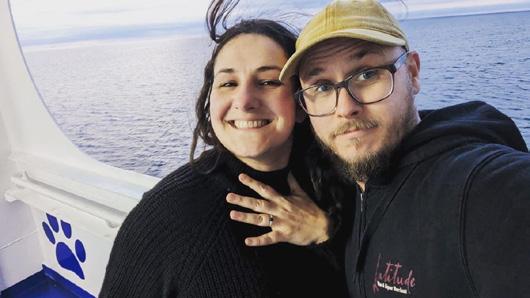
Great to see our friends at Corc in Barry running a ticketed tasting event inspired by The Judgment of Paris, Steven Spurrier’s momentous tasting event that spawned a Hollywood film, and would have spawned a second one too, had the great man – who was appalled at Alan Rickman’s portrayal of him in Bottle Shock – had his way. Just a shame that the Corc event took place in the Vale of Glamorgan and not a little further north. Then they could have called it The Judgment of Powys (so that joke’s back, is it? Ed).
Let’s hope that the scumbags who broke into Finley’s in Hoxton at the end of May, trashing the place and stealing pretty much all the stock, are tracked down quickly with the help of the CCTV footage that Sia Smith was able to share with police. Like many other indies of this type, Finley’s prides itself on reflecting “the diversity of our local community” and being “a place where everyone is welcome and feels right at home”. Assuming, of course, they aren’t intent on destroying the hard work of a small business owner with enough challenges on their plate.
Lower Wine Bar & Shop opened in Waterloo, London, in February. It is the first venture for friends Alex Pitt, Blaise Coley and Skye Alejandro, who all have hospitality backgrounds.
Pitt worked at the 10 Cases restaurant and wine bar in Covent Garden for over five years and has also made wine with Heidi Shröck in Austria.
“I really got stuck into the buying role at 10 Cases. It was a great place to work and they almost let me run it like it was my own,” he says.
“There’s so much amazing wine out there and what seems like an endless amount of suppliers. I think over my time at 10 Cases I worked with 50 or 60 of them.
“At Lower Wine it’s much smaller, but I’m still working with about 30 suppliers. I’m probably making a bit more work for myself but I do love that side of it. I suppose I am a bit fickle in my buying habits and I don’t want to have a static wine list. I want it to be quite fluid.
“A lot of the wines are from producers that I’ve met, either in London or I’ve been out to visit. I had a nice trip to Greece last year, which was really insightful, so I’ve got a couple of really nice Greek wines on the menu.
“I would say the list is made up of good, honest artisanal wines. I’m trying to get away from the buzzword ‘natural wine’ that everyone chucks around but doesn’t really have any idea what it means. I find that a bit exhausting sometimes.”
The premises could be described as cosy, but there is capacity for 25 covers on the ground floor and the shop is in the cellar. Pitt says: “The retail element isn’t huge – it probably accounts for about 10% – but it is definitely the sector of the business that I’m trying to grow.
“The whole business model was pretty low-key,” he adds, “as we’re on quite a

short lease, and we had a lot of help from people setting it up. Blaise’s dad and her brother basically fitted it out and everything we got was second-hand apart from the freezer and the convection oven. “There’s definitely a possibility of expansion, but I don’t want it to be too quick just because I think we’ve got something quite special at Lower and we’ve got a really nice little neighbourhood and so many regulars already.”
• Wilding on Little Clarendon Street in Oxford has closed. The wine bar and restaurant owned by Kent Barker was launched in 2021. Barker confirms he has sold the business, which ceased trading on May 25, and hints that he has other projects in the pipeline. Barker recently closed his Eight Stony Street wine bar and restaurant in Frome, Somerset (The Wine Merchant, February).
• Ex Cellar, owned by former Oddbins owner Simon Baile, relocated last month from its original site in Claygate in Surrey to a new premises in Kingston upon Thames.
Wells-next-the-Sea will soon welcome North Norfolk Cellars, a wine shop owned by Bert Blaize.
If his name sounds familiar, it’s because four years ago he was tasked with setting up the Bottles ‘N’ Jars deli in London, but this time the project is solely his.
The shop will be the physical incarnation of his online wine business of the same name, which he established last August.
“It can be pretty soulless selling online,” says Blaize. “I’m lucky enough to get quite a decent amount of allocations for things and then people swoop in, buy them and they’re gone.
“I try to reach out through a note in the package or follow up with an email, but
that’s it. With the shop I can have things open for people to taste before they buy, as well as be there to chat to people. It’s a much more fun way of selling.”
Once Blaize has the licensing signed off – the council baulked at the application because it got a bit focused on the bar element of the hybrid plan – he will open the doors mid-June.
“We’ve got two window seats, which look out onto the harbour, and they seat four each,” he says.
“There’s a tasting table in the middle of the shop and that can fit six or eight and then, weather depending, we can get a couple of tables outside, right on the quay.”
Blaize hopes to make the most of the tourist season as he admits the shop is, in the short term, essentially a pop-up.
“I’m testing the waters,” he says. “But

we’ve got a couple of Michelin-star restaurants up here now and there’s definitely people spending money on good food and wine.
“The food scene in Wells is amazing; it’s famous for crab and lobster. I’d like to collaborate with some local food businesses. I’d love to get them to come and do an afternoon with everyone out in the harbour enjoying local seafood and some great wine.”
• Amphora in Cambridge is “taking a break” after its landlord decided to pursue a different option for the premises. Owner Cong Cong Bo says the hybrid wine shop and bar will probably reopen at a new location later this year, and in the meantime she is planning a series of customer events and hopes to continue selling wine for local delivery.


Ifound myself lying awake the other night, mentally composing the email
I was going to send back to the chair of the local Rotary club. The bit of his late evening email that caused insomnia was, “I have told the hotel that you will supply the glasses”.
I’m pretty sure that during the last month’s trail of emails back and forth I have always finished by reminding him to check that the hotel is happy to supply enough glasses for everyone to have at least two.
I probably have enough tasting glasses in the shed but they will be full of spiders and need washing. It also means I have to wait around until the last person has finished drinking, pack up the dirty glasses, take them home and wash them again. Washing dozens of glasses twice is not my idea of fun.
It all started a few weeks ago when I received the first email. Would I be willing to put on a wine tasting event for the local Rotary club? My reply was when, where, how many, what budget and a dozen other questions. My initial instinct was to simply say no. My experience is that you jump through a lot of hoops before they reveal their budget is £5 a bottle. By the time I’d got answers to some, but not all, of the fundamental questions and agreed an achievable budget, it had been assumed that I was up for it.
How much will it cost per head? I explained that the pricing was dependant on numbers. For eight wines averaging £x it would be 8 x £x for up to 15 people.
For over 15 people, that would double, as we would need a second bottle. And so on for every multiple of 15. The price per head depended on how far from the step changes they ended up. I provided a graph. They anticipated up to 30 people and, as it wasn’t for a few months, I didn’t give it much more thought. By the time they’d got answers from everyone the numbers had dropped to about 10, so it was abandoned. Hooray!
As you might expect from the Rotary, though, it’s gone full circle. A week later I got another email saying some bright spark had suggested that they combine it with their next meeting – the worst possible idea. That next meeting was in eight days’ time and followed a bank holiday weekend. The chair copied me in to an email he’d just unilaterally sent to his membership, explaining that they’d deal with any urgent business and then at 7.45pm I would give a talk on “a wine region” followed by a tasting of four whites and four reds from that region.
That is not what we had talked about and not what is going to happen – I was initially hoping to be done by 8pm too. What “region” could we do where we could find four whites and four reds within the
price limit? We have sufficient range in Burgundy, but just two bottles would blow their entire budget. Bordeaux or Tuscany? We’d struggle with the whites. I wanted to do “weird and wonderful” as a theme. If they want a region then that region may have to be “Greece, the Balkans and Caucasus plus India, and possibly Niagara too”.
Oh, and rather than their normal sitdown meal, the hotel is going to lay on a cold buffet, he hopes, for them to eat while I’m talking. He has yet to make good on his promise to pop into the shop and discuss arrangements with me, which is the problem. He’s guessing how it may work –and guessing wrong.
Of course, the thinking about these things is that it’s not about the income from the evening but about gaining new customers. That’s the other bit that concerns me. We are a small town and I probably know most of the Rotary club members from various town events and meetings. I certainly do not know any of them as customers.
I was once discussing the health of the high street with a prominent Rotarian and ex-mayor when she just shrugged and told me that she always did all her shopping at the big Waitrose in the neighbouring town. Like the current chair, she has never once set foot in my shop. Maybe they don’t drink? (They do!)
Why would she, or any of her Rotarian colleagues, change habits, use local shops and start buying proper wine after tasting a random selection of entry-level bottles?
We often do tastings for a local wine club. They are great. They pay for four bottles each of eight fairly expensive wines and spend thousands off the back of the event. They are all enthusiastic about wine, willing to learn more – and they supply their own glasses!
I probably have enough glasses in the shed, but they will be full of spiders
The Rotarians, on the other hand, have never shown any interest in wine and will be there under a three-line whip. A tough crowd and flouncing out halfway through is not an option.
With just three days to go, they cancelled … again. Luckily I hadn’t bothered to sort out the glasses or order any stock.

Buckingham Schenk is understandably chuffed with its new partnership with Hatch wines, the Australian producer founded by Chris Hatcher, who was Wolf Blass’s chief winemaker for 27 years. There are two Rieslings and two Shirazes in the line-up, with this one promising to be the star of the show once its oaky edges and big, bold fruit truly merge and mellow.
RRP: £35 ABV: 14%
Buckingham Schenk (01753 521336)
buckingham-schenk.co.uk
The fruit comes from a plot known as La Ladera in Chile’s Cachapoal Valley, where the days are warm and the nights are cold, with all the good things that implies for viticulture. There’s a dark-berry character to the wine but a leafy, stalky, nettley dimension too, and a smokey, savoury aftertaste.
RRP: £16 ABV: 14%
Fells (01442 870900) fells.co.uk
Followers of this (genuinely) iconic Yarra Valley estate know that this is the blend upon which it built its reputation, and a few sips of the ’17 is all it takes to understand why that might be. It’s an homage to fine Bordeaux, with the muskiness and cigarbox characters that suggests, with a generous and satisfying Aussie dollop of dark berry fruit.
RRP: £64 ABV: 13.5%
Berkmann Wine Cellars (020 7609 4711) berkmann.co.uk
From the Western Cape comes yet another red blend that overperforms at its price point. Here the component varieties are vinified and aged separately before a final blend, which brings out the signature characteristics of each one. It’s bursting with flavour, making it an eminently credible crowd-pleaser.
RRP: £11.99 ABV: 13%
Alliance Wine (01505 506060) alliancewine.com




This is arguably the wine that every Chardonnay producer on the planet would like to emulate, just because it gets everything right: the gentle floral aroma; the nuts and stone fruit on the palate; the silky mouth feel; the persistent, yet understated, finish. A classy wine that doesn’t try too hard to impress.
RRP: £42.30 (for 2021 vintage) ABV: 13.5%
Hatch Mansfield (01344 871800) hatchmansfield.com
Maybe a Sauvignon Blanc at 11% isn’t a prospect to set the indie pulse racing, and we were prepared to be a little underwhelmed by this Côtes de Gascogne bottling. Yet what a pleasant bank holiday surprise it turned out to be, with its subtle grass and grapefruit undertones and easygoing freshness. Despite the name, it’s not really big, but it is quite clever.
RRP: £10.99 ABV: 11%
Cachet Wine (01482 638888) cachetwine.co.uk
Chardonnay takes the lead here, with Savagnin contributing a modest 30%, but its presence is clearly felt. As is the convention in these parts, the wine is aged in oak barrels under a layer of yeast and emerges rather like an unfortified fino. The familiar, fumey, bready character is tempered by a zesty juiciness.
RRP: £39.99 ABV: 14%
Alliance Wine (01505 506060) alliancewine.com
Muscadet-based Huchet is on a mission to strip back winemaking to the absolute fundamentals, and shelters under the Vin de France umbrella for this aromatic and zippy Sauvignon Blanc/Melon de Bourgogne blend. A clean, cultured and uncomplicated wine that makes the mind wander towards outdoor lunches.
RRP: £16 ABV: 12%
Bancroft Wines (07920 195183) bancroftwines.com (or Terroir in Scotland)





This year’s Big G trade event in London was a big success, reflecting trade enthusiasm for German wine in all its forms.
Twenty-five importers and producers took part in the tasting and masterclasses, which were attended by independent merchants as well as their on-trade counterparts.
Nicky Forrest, managing director of Wines of Germany UK, says: “It couldn’t have been clearer from the wines on show that this is a truly exciting time for German wine.
“Dry Riesling is classier than ever; thrilling Sekts are being produced and gaining distribution in the UK. Pinot is going from strength to strength, and the time is ripe for lighter styles.

“Indeed, Germany’s strength as a Pinotproducing nation is clearer now than it’s ever been. We are seeing more and more on shelves, especially in the independent retail sector, where Spätburgunder is recognised for its calibre, value and, as we saw at the Big G, of course its potential for ageing. There are great opportunities for German Pinot at the moment, and we definitely expect it to win more shelf space in the near future.
“Another theme which we explored in greater depth at the Big G was lighter styles of German wine for modern lifestyles. Changing consumer habits and new duty rates mean German wine has an opportunity to shine, with a wealth of styles under 10.5% abv.”

In this year’s Wine Merchant reader survey there were encouraging signs for German wines.
Almost six in 10 respondents (58%) agreed with the statement “once we speak to customers, they are interested to try German wine” – up slightly on the 2023 survey. Almost eight in 10 indies say that most of their German sales come as a result of hand-selling.
Most independents – 54% – focus their German efforts on Riesling and Pinot Noir. But 20% say they “sell lots of German varietals”.
The survey suggests that the trade’s well-known enthusiasm for German wines is being transmitted to consumers.
“We encourage people to buy dry Riesling and Spätburgunder to accompany any meal. Also to bring to friends as a unique gift,” said one respondent.
Another added: “I think customers are becoming increasingly aware of German wine quality, and we are selling more and more for general consumption regardless of occasion.”
According to a third respondent: “We have established a group of customers that regularly buy Riesling now, not just from Germany, as they have tasted it through in-store promotions, including 31 Days of German Riesling.”
One merchant said that German Pinot Noir is “becoming an accepted alternative to Burgundy”, with customers appreciating “cheese pairing or fish/sushi suggestions”.
Spicy food was mentioned by many respondents as the perfect match for German wine. But several also cited its popularity as an aperitif.
In association with



Just over five years ago we published our first Rising Stars column, which featured Emily Silva, who was nominated by Ted Sandbach at The Oxford Wine Company.
Today Emily is head of retail and marketing with the final stages of her MW in sight, and she is perfectly placed to spot the talent following in her footsteps.
“Katy joined us in February 2020 and, because of the pandemic hitting shortly after, she had a real baptism of fire, but she did a fantastic job,” explains Emily.
“Katy has great wine knowledge and she completed her Diploma earlier this year, but she wears it very lightly. She’s a real natural with customers and is very, very good at talking to them on whatever level they are at. She’s hosted a number of really good fun themed tastings. She did one called Unpronouncables, which focused on weird grape varieties.”
In four years, Katy has progressed from retail assistant to retail marketing manager. “When it comes to marketing, she is my right-hand woman,” says Emily. “She has quite an artistic side and does some great displays.”
As an English literature graduate, Katy says she’s attracted to the romance of wine, and first considered it as a career after listening to a family friend, who happened to be an MW. “I was completely fascinated by the way she spoke about the industry,” she says. “I liked wine anyway, and my parents encouraged me to do my WSET Level 2. Then I just completely fell headover-heels in love with it.”
After spending a Christmas season working at Waddesdon Manor, Katy found herself at OWC shortly before Covid hit. She says: “I remember sending Ted an email saying I’ll deliver wine, I’ll pick orders or work in the warehouse or work in retail. Literally whatever you need me to do, I’ll do it.”
Hence her “baptism of fire” at the Botley Road shop, where she was the only member of retail staff for about three months. “Although it was absolutely terrifying at the time, and it may be awful to say, it is probably one of the best things that ever happened to me,” she says.
South Africa and Germany are near the top of Katy’s travel wish list. “I love South African Chenin Blanc and we have one called Illimis which is made by Lucinda Heyns. It’s one of my favourite wines of all time. And I definitely had a wine moment, when you taste something and it just changes your perception

of everything, with a Mosel Riesling from Saskia Prüm,” Katy says.
“I see myself right at the beginning of my career,” she adds, “and every day that I work in this industry it seems so surreal. I just enjoy sharing the love of wine and introducing people to it, inviting them to enjoy it in an unintimidating and accessible way.”




Lobby your election candidates now
A general election means more opportunities for local lobbying! It is imperative that we continue to leverage pressure on sitting MPs contesting their seats and prospective candidates that will make up the next parliament. Please explain your concerns about the February 1 duty easement deadline, and argue to make the easement permanent. A new government offers us a fresh opportunity to highlight the value of our sector and achieve positive change.
We would love to hear from you about how an end to the duty easement will impact your business. You can find a threeminute survey on the WSTA website, which will really help us to quantify the impact to independent businesses..
Innovation on show at the LWF
There was a noticeable number of new products in the no and low-alcohol wines category on show at this year’s London Wine Fair. The sector continues to gain share in the market: in the past 12 months, it was the only category not to experience a decline in volume. The number of exciting new products and producers at the fair suggests that there is even more innovation to come including wines that contain no sugar, and therefore fewer calories. Sustainability too continued to be an incredibly important theme at the fair; lighter weight bottles and alternative formats such as cans and paper bottles were prevalent.
Bigger indies need to enrol for EPR
This summer sees the establishment of Extended Producer Responsibility, placing significant costs on producers and importers for the collection, sorting and recycling of packaging. Fees were deferred to October 2025, and obligated wine merchants should already be collecting this data. According to Defra, the EPR scheme administrator will be appointed in December.
Defra’s deadline for obligated businesses to enrol and report their packaging data has now passed. Extended Producer Responsibility (EPR) paperwork needed to be submitted by May 31, 2024 to avoid a fine. Companies will need to act if their annual turnover is £1m or more and were responsible for more than 25 tonnes of packaging in 2022. WSTA estimates that only 50% of eligible businesses have submitted their paperwork.

Together, we can put a stop
Hal
calls on every independent to put
We need to unite to force a change in government policy.
Rishi Sunak is getting a reputation for being really inept at politics and his announcement of a general election in the pouring rain is just one image that demonstrates it.
He’s none too popular with his own backbenchers as a result, many of whom will be out of a job on July 5. I understand that 60 Conservative backbench MPs have written to the Treasury asking Jeremy Hunt to make the duty easement permanent, 10 more than would be needed to force a leadership election. They have been told to stop bothering them as there is no way the policy will change.
The WSTA has also come in for criticism from Treasury officials, who will no longer agree to meetings and even accuse chief executive Miles Beale of lying to MPs (he hasn’t!).
All of this proves that we are getting under the skin of this government, who are finding it more difficult to justify carrying
out Sunak’s anti-business, prohibitionist and frankly un-Conservative policies.
We need to keep going and more than likely will need to persuade an incoming Labour government to do the right thing. The general election campaign provides us with new opportunities to meet with and persuade MPs and prospective candidates to change the policy.
For context, I and other indies were involved in a panel discussion at the London Wine Fair of what was keeping us awake at night. While new labelling requirements and ever more costly environmental responsibility featured
We need the duty easement to carry on indefinitely. It’s not difficult to achieve: just remove a sentence from the legislation

pressure on their election candidates to avoid a policy that will damage us all
strongly, it was the refusal of the government to entertain making the duty easement on wines between 11.5% and 14.5% permanent that really gave us the night sweats.
Whoever imports the wines we sell, it will become massively more complex and costly to calculate duty, and therefore arrive at a true cost, if the easement comes to an end on February 1, 2025.
The decision to go ahead with a tax system for wine that will mean a different calculation of duty for each of the 136 possible abvs between 8.5% and 22% (wines can be labelled to 0.1% abv now, another Brexit freedom) doesn’t bear much scrutiny under the lens of reality. Sadly it is Sunak’s policy and not up for scrutiny.
Perhaps he really believes that alcohol duty reform is part of his legacy to the nation. By linking duty to public health, raising wine duty massively and making it ever harder to administer, he may well
have convinced himself that the electorate will just give up drinking wine and enjoy healthier lives as a result. That is definitely a minority view among MPs, though, and is obviously one that will force most of us out of business if we can’t change it.
During an election campaign your MP will be spending more time in their constituency and looking for ways to engage with the electorate. What better way than visiting local businesses? Whoever your MP is, and your colleagues’ MPs are, please write to them as soon as you finish reading this call to arms.
Find out who the prospective candidates are from other parties and write to them too. Even if you have spoken to or met them already, please do it again. Invite them to visit your business to discuss how they can help SMEs grow the economy. For readers in England, perhaps English Wine Week (June 15-23) presents an opportunity for a meeting and photo
opportunity.
If you do meet, remind them that the government is refusing to even consider the simplest of amendments to its policy, the only one demanded by the entire trade, and one that doesn’t affect the intentions of the policy but rather makes it possible to manage.
The current legislation already includes the solution of the easement but it has a sunset clause. The government knew there was a problem with the policy, adopted a workable solution, then wrote into the law that the solution will come to an end on February 1, 2025.
We need that sunset clause to be removed and the solution allowed to carry on indefinitely. Nothing difficult to achieve, no drama: just remove a sentence and move on. Whatever party they stand for, your MP works for you, and must realise both the common sense of our demand and the dire consequences for your business if it is ignored. If we all do this, we will not be ignored, and the new government will be forced to consider its position.
Trying to get the Labour leadership to commit to anything at this stage is incredibly difficult but it is crucial that all Labour MPs, and even prospective candidates, know that the easement must be made permanent, that it is incredibly easy to achieve politically, and it needs to happen within the first few months of the new government taking office.

At least there will be time to keep campaigning after July 4, with seven months before the sunset clause takes effect. Please go to members.parliament. uk/FindYourMP; for prospective candidates try whocanivotefor.co.uk/ ppcs, or dig out your last email, to make another demand for the change we really must bring about if our beloved independent wine trade is to survive. Thank you.


Iʼm the international liaison officer here at the Wine Marketing Board.
You probably wonʼt see much of me as my job takes me to far-flung locations, where I do my bit to fly the flag for our wonderful industry and forge new alliances where I can.
I know most of you would never have time for so many trips, tastings, field visits, receptions, dinners and awards ceremonies. So think of me as your ambassador. Iʼm always happy to hear from you, time zone permitting.

customers we could do without
... It’s been an interesting tasting … really good to try all four wines, though I wasn’t so keen on that last one, but that’s just me, I’m not a big Sauvignon fan, I just find it a bit too commercial and obvious … oh that was the Catarratto was it … and that was £16.99 … OK, £24.99, I was sure you said £16.99 … so the third one was the Sauvignon … and that’s the one you’ve got on special offer? Right, so they’re all on special offer … wine number one, the Chenin … sorry, Chardonnay … that was £14.99 before or after the 10% discount? You’re saying £18.99? Now I’m confused … so wine number two was £14.99 and that was Chenin … you’re saying Chablis, OK, whatever … that’s the one which had that beautiful drawing on the label … no, you’re right, that could have been the mineral water … actually I might hold fire for now in any case, I need to go through my notes again and have a think … those water biscuits were quite pleasant, though … how much are they?

1. What’s the name of the Catalan sparkling wine category created in 2017 by disgruntled Cava producers?
2. Bacchus, the classical god of wine, is also known by which name?
3. Australia’s Durif grape is better known by what name in the Americas?
4. The first London Wine Fair took place in 1981, on premises operated by which department store? (a) Selfridges (b) Allders (c) Derry & Toms?
5. In the novel The Silence of the Lambs, Hannibal Lecter claims to enjoy eating his victim’s liver with fava beans and a glass of Amarone. What wine does this change to in the film?

Answers on page 62

In a nutshell: Sarah has secured a page of advertising in a popular local calendar, which is practically guaranteed to be in the homes of everyone in her catchment area. Plus she enjoyed the fun of a photoshoot, which gave the business a social media boost.
Tell us more.
“You see this calendar pretty much everywhere you go in Sandwich. For £100 sponsorship we get our own month, which will feature a local dog, and you get your logo at the bottom along with some information about your business.”
Do you need to have a dog to take part?


“No, the team behind the project take care of all that. Often it’s one or two dogs for each month, but in our case we got three terriers: Billy, Alfie and Fred. They are best friends and go for a walk together every morning.
“We did the shoot in our shop and it was bonkers. We stayed open and people wanted to come in to see what we were doing. So just the shoot itself generated loads of interest.
“We had loads of fun. One of the dogs apparently loves sitting on logs, so the photographer put him on top of a barrel. He was really well behaved until they put a party hat on him.”

Who puts all this together?
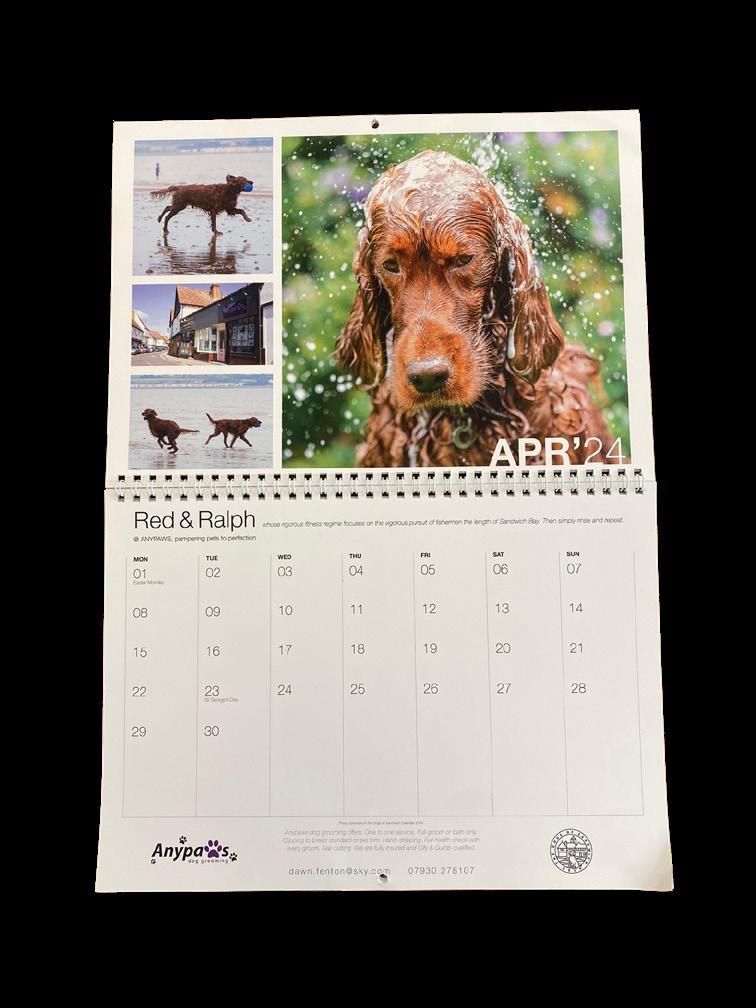
“We’re lucky that there’s a team of talented local people who, because it’s for charity, give their time for free. The calendars sell for £10 each and they sold about a thousand of them last year.”
Is 2025 the first time Hercules will make an appearance in the calendar?
“Yes. I’ve only been here since December [Sarah took over when previous owner Sarah Dodd sold the business last year]. But I’ve bought the calendar myself in the past. Sandwich is a very dog-friendly place
and it’s lovely to have the calendar because you know all the local dogs. Last year my friend’s dog was in it and the children got so excited and every morning were like, ‘look, there’s Bolt!’ So when I was asked if I wanted to be part of the 2025 calendar I said yes. It’s a really good way to be involved in the local community.”
What month will you be?
“We’re going to be January, because we were thinking that is such a quiet time in the shop, you never know, it might encourage a few sales.”
Sarah wins a WBC gift box containing some premium drinks and a box of chocolates.
Tell us about a bright idea that’s worked for you and you too could win a prize.
Email claire@winemerchantmag.com
 James Hawkins
James Hawkins
Hawkins Bros Godalming, Surrey
Favourite wine on my list
At the moment it’s Riverview Chardonnay 2021 from the Crouch Valley in Essex. A shining example of just how good English still wine can be.
Favourite wine and food match
The rapier acidity of Ambriel English Reserve Demi-Sec with blue cheese and truffle honey is an ecstatic combination.
Favourite wine trip
The Cape, South Africa. A six-course lunch with paired wines at La Colombe on the Constantia Uitsig Estate being a particular highlight.
Favourite wine trade person
James Craig Wood of Ellis & Co has an expansive knowledge of wine and never fails to entertain with his ability to charm and be improper in the same breath.
Favourite wine shop
La Reserve (now Jeroboams) on Walton Street. A place I loved to visit when I first got interested in wine, to salivate over their awe-inspiring selection.
More than two-thirds of beer and wine sold in pubs and bars is shortmeasured, costing the average consumer about £115 a year, according to research.
Trading standards officers visited 77 venues across the UK, finding 96 short measures out of 137 test purchases, meaning approximately 70% had less of the drink than had been declared or paid for.
The Guardian, May 24

“There you go – four pints. That’ll be £37.50”
Dr John Gladstones, the man who identified Margaret River as an ideal region to produce high-quality wine, has died aged 92.
Gladstones was widely known as the “godfather of Margaret River” after recognising the region’s vast potential back in 1966.
Two years ago he was made an Officer in the Order of Australia in recognition of his service to viticulture and agriculture. Decanter, May 28

The European Committee of Wine Companies (CEEV) is calling on the EU for measures to help wine producers face their current challenges.
“Unpredictable extreme weather events, inflation, increased production costs, geopolitical uncertainty, demonisation of alcoholic beverages … the EU wine sector is facing a set of structural and conjunctural challenges that are putting in danger its long-term sustainability,” CEEV president Mauricio González-Gordon said.
The group is looking for a “pragmatic” EU health policy that differentiates between alcohol abuse and moderate wine consumption. This would involve a move away from the World Health Organisation’s data in favour of EU state data and a single health policy.
Just Drinks, May 28
French billionaire François Pinault is reportedly in talks with the de Montille family with a view to purchasing the latter’s Château de Puligny-Montrachet winery.
According to a report in French business weekly Challenges (run by Pinault’s luxury goods rival Bernard Arnault of LVMH and publisher Claude Perdriel), the Pinault family’s wine portfolio, Artémis Domaines, is looking to rejig its Burgundy operation following the acquisition of the Beaunebased estate and négoce operation, Bouchard Père & Fils, in 2022. Wine-Searcher, May 26
The London Wine Fair has reported a decline of 8% in visitor numbers for this year’s show, but an increase in the quality of the overall audience.
Total (net) visitors for 2024 stood at 9,243, which was 8% down on 2023, with the visitor audience “almost identical to 2023” according to the organisers, with 31% from the on-trade and 22% from the off-trade.
The visitor-to-exhibitor ratio was 23 visitors to each exhibitor, which was four times that of the fair’s larger competitors, according to Brintex.
Exhibitor numbers were “fairly static” compared to 2023, with 401 companies attending the show, a fall of 16 on last year. Drinks Business, May 24
• Austrian winemaker Andreas Pernerstorfer has uncovered mammoth bones while renovating his wine cellar. The discovery has been dated by experts from the Austrian Archaeological Institute using stone artifacts and charcoal found at the site, which suggest the bones are between 30,000 and 40,000 years old. Independent, May 24
Pint-sized bottles of wine will be allowed on UK shelves from the autumn.
Business minister Kevin Hollinrake said the measure will support the “thriving” UK wine sector by providing opportunities for “innovation and greater choice”.
But the SNP’s Patrick Grady said the government should admit there is “little to no demand or interest for this supposedly glorious Brexit benefit”. Sky News, May 2
Have you ever made your own wine,



�We went through a phase of trying to make sloe gin as well as toffee vodka and both were quite successful. The sloe gin involves quite a lot of preparation; gathering berries and then tending the jars for weeks. For the toffee vodka, we just got some vodka and then put some Werther’s Originals in and let them dissolve. It made good Christmas presents and, such is the miracle of toffee vodka, after we gave it to some friends as a gift, they later found out they were pregnant.”
Fred Davids H Champagne winner H Kelder Wines, Manchester
�In the early days of my career with Laymont & Shaw we had to create a new wine for the multiple sector. I wasn’t involved in the winemaking, just the blending. It got a silver or something at the IWC but I didn’t have a clue what I was doing, so I think it was more luck than judgement. Then a few years ago I thought I’d make cider with apples from my garden. I bought the fermentation kit, everything you need, and got a lovely batch of vinegar.”
Jamie Tonkin
Old Chapel Cellars, Truro




�I did a vintage with London Cru in 2020 and I’ve worked in wineries in Oregon and France, so I’ve made wine with other people but never made my own. However, I have planted three Müller-Thurgau vines in my garden and I’ve just bought a home winemaking start kit online, and I’ll give it a shot at some point this year. I thought it would be fun and I had this tiny idea in the back of my mind that at some point in the future maybe I could find a small industrial unit and start a little urban winery.”
Bryan Houde
The Cellar by Wine Monkey, Chippenham
�If I was given the opportunity to make wine I would absolutely run a mile and close the door on the way out, because I know how much money people have sunk into making wine, in this country particularly. I know I can sell what’s in the bottle but I’m not interested in bottling it myself, that’s for sure.”
Conor Nolan
The Secret Cellar, Tunbridge Wells
The oldest wine house in Champagne: Äy 1584
 Champagne Gosset
Champagne Gosset


bon jovi forever EMI

Cliff, Gary, Pink, Kylie, Post Malone and Snoop all have wines out. I’m not a fan of their generally uninspired, music-by-numbers output and the wines I have tried are all the same: insipid, too sweet, with little care going into them. However, someone gave Mrs Winyl a bottle of Jon Bon Jovi Hampton Water Provence rosé the other day and it was very enjoyable. Made by Gérard Betrand, it had some heft to it; it was quite meaty, with punchy, vibrant fruits and a pleasant, lingering aftertaste. Coincidentally Bon Jovi have a new album out, Forever, together with a Netflix documentary Thank You: Goodnight to mark their 40th anniversary. I’ll admit to a soft spot for old JBJ, as a veteran of Monsters of Rock, back when it was a one-day festival packed with the top names in metal and rock. AC/DC, ZZ Top, Ozzy, Metallica, Scorpions, Van Halen and yes, Bon Jovi, still full of youthful exuberance, flowing hair and scarves, delighting the teenage Mr Winyl. Bon Jovi’s last album 2020 was pretty downbeat, which didn’t work for fans who expected the upbeat big anthems, fun and joy that are a hallmark of Bon Jovi’s music. So joy is a theme of this album, which celebrates the band’s survival, especially after vocal surgery in 2022. Lead single Legendary references several famous songs that everyone will happily sing along to, and I guess this is what they are hoping with this album: to create another turn-up-thevolume, feelgood Bon Jovi record. Let’s hope it’s as good as his wine.
Steve Tattam is owner of Winyl, a wine and record shop in Manningtree, Essex

We saw dozens of indies on our London Wine Fair stand. It was great to see new as well as familiar faces tasting our Top 100 winners

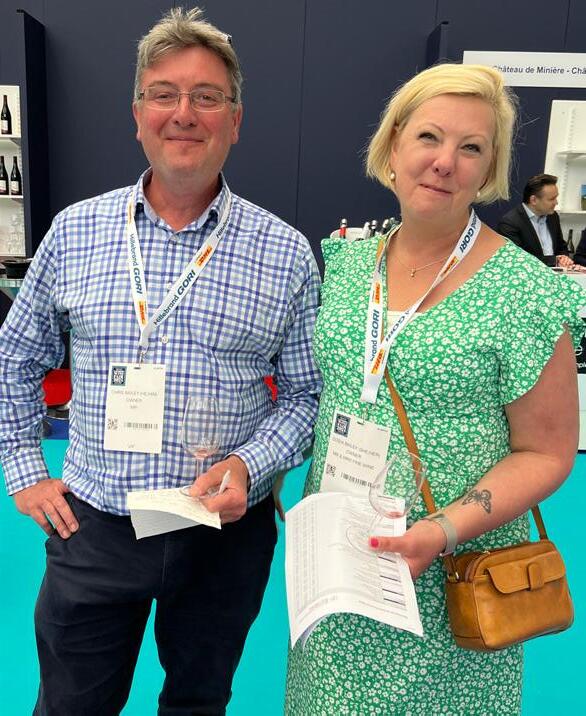


Pellegrino is proud to be a seventhgeneration wine producer, and just as proud of its deep-rooted Sicilian heritage.
“Each generation has had the opportunity to grow up immersed in the winemaking environment, learning the secrets of winemaking and developing a love and enthusiasm for this incredible product,” says the company’s Daniela Scarsi. “Wine embodies the culture, history and tradition of our family.”
Pellegrino is based in the west of Sicily, where it works from two cellars using organically grown fruit from a mosaic of landscapes spread over 150 hectares in the province of Trapani. It has an abundance of “micro-terroirs”, explains Scarsi, “which allows us to obtain memorable expressions of native Sicilian varieties”.
Gazzerotta is the largest estate (90 hectares), ideal for Nero d’Avola and ancient Grillo vineyards. “It is also home to experimental Malbec and Frappato plantings,” Scarsi says.
Salinaro takes its name from the nearby salt pans. This 14-hectare estate, with calcareous and sandy soil, produces a savoury and mineral white wine from Grillo grapes.
Kelbi, at 150m above sea level, is a 19-hectare estate with red soil, rich in iron, with an excellent capacity to store water. Scarsi says: “It’s perfect for the cultivation of Catarratto, which expresses itself here with typical herbaceous notes.”
Rinazzo is an 11-hectare estate with sandy and gravelly soil. It’s dedicated to Syrah, which emerges as small, thickskinned grapes.

Pellegrino’s reputation is built on family values, and indigenous grapes
In association with UK importer Fells
Rakalia is located in Marsala, where the fertile soil and favourable climate is perfect for Malvasia.
Siba, in Pantelleria, is an 8-hectare estate with volcanic soil and a Mediterranean climate, perfect for Pellegrino’s prized Zibibbo grapes. “It produces our cru, Isesi: a white that stands out for its aromatic finesse and marked minerality,” says Scarsi.
Pellegrino has “gradually abandoned international varieties, such as Pinot Grigio and Cabernet, to focus on the native ones,” says Scarsi.
“The native varieties are rooted in our terroir and represent the identity and history of our region.
“We made an exception with Malbec, as it has become very popular internationally

and has proven to adapt perfectly to our climate and soil. We are the first and only ones in Sicily to produce wine from Malbec grapes and we are proud of it.”
Climate change is “definitely having an impact” on Sicilian viticulture, disrupting temperature and precipitation patterns, says Scarsi.
“Pellegrino has diversified the vines, planting those that are more resistant to heat or drought, such as Perricone, and implementing new vineyard management techniques to mitigate the effects of climate change.”
Those efforts are ongoing, and the company is also focused on refining all aspects of what has made it successful over the course of more than 140 years.
“Our commitment is to constantly improve the quality of our wine and to seek new market opportunities to make its unique characteristics increasingly known and appreciated,” says Scarsi.
“We are determined to consolidate our presence on the market and make Pellegrino wines reference products in the wine production of our region.
“We want to continue to enhance native vines and also promote dry Zibibbo, both locally and internationally.
“We were among the first to produce dry Zibibbo in Pantelleria. Zibibbo is an indigenous vine that offers fresh and aromatic wines, perfect for accompanying fish and seafood dishes typical of our culinary tradition.”

Despite being in the booze business for over 20 years, I’ve never made it to the London Wine Fair. It would’ve been time-consuming and expensive to book a special trip, and as I was happy with my existing suppliers there seemed little chance of a commensurate return. But this year, when a family visit took me to London mid-May, it seemed fated that I should attend.
I can’t say if the fair was better or worse, less or more useful, than previous years. The Drinks Business website is claiming “London Wine Fair sees visitor decline but improvement in audience quality”. I don’t think the rise in quality is linked to me attending for the first time, but rather the amount of serious interaction between exhibitors and visitors. As one regular said to me: “The show’s more serious this year, less celebratory.” I took my two days there seriously, for sure, and I found plenty to enjoy if not celebrate.
The French stands were showing particularly well. Despite the valiant efforts of countries like Moldova, Ukraine and Greece (more than 40 producers!) the variety and quality of the French wines made them the most commercial for me. They’re the cheapest to import directly,
Who doesn’t want to try Taylor’s 50-yearold and Peruvian dark chocolate at 10.30am? I was 30 seconds too late

which helps, though I wish the winery I spent an hour discussing buying a pallet from had mentioned in advance that they already have an exclusive agent in the UK. It would also have been good to get advance notice of the programme of tastings, talks and other events. I kept checking on the LWF website, but it seemed to be only a day or so before opening that the details were revealed. This made it hard to plan, and I do rue being 30 seconds too late for the cut-off for Tuesday morning’s port and chocolate tasting. I mean, who doesn’t want to try Taylor’s 50-year-old and a 65% Peruvian dark chocolate at 10.30am? We sell a lot of port and we sell a lot of chocolate, but do they really match? It seems I will have to do my own research.
One tutored tasting I did make it into was a fascinating one on sake. I learned a lot, and I also smelled the most disgusting liquid I’ve ever encountered in a professional context. (I’m excluding that time a student friend downed a whole pint
of snakebite and then … oh never mind.) To avoid unnecessary shaming, I won’t name the sake in question; all I’ll say is that it was pink and sparkling, and when the tutor asked at the end for votes on favourite glasses, it received nul points.
A comparative tasting of eight sparkling Vouvrays was also very educational, not to mention very acidic. Its only rival in enamel-stripping was the sandwich I had at lunchtime on Monday. That was about the size of my head, with a filling consisting of a slice of something pink, shreds of something green, and strips of something red. I can be no more specific. It was smeared with a pickle of extraordinary ferocity and was priced, as we say in the trade, ambitiously.
What of my ambitions? I wasn’t depending on making any significant deals, so couldn’t be disappointed, but I did find one potential new wholesaler and two producers I’d like to import directly. If I had more room on my shelves and more money in the bank I could’ve started more serious conversations, but I’m happy with that level of business.
On top of my focused activity, I enjoyed generic tastings from New Zealand and South Africa – though the enjoyment was hampered by them being crammed into a ridiculously small enclosure near the entrance. It needed to be twice as big. And that attendee who insisted on standing in front of the spittoon while composing a long text home … gonnae no do that?
Three cheers for the Wine Merchant Top 100, which was laid out with plenty of elbow room. And well done to the judges, who selected a fantastic range of winners in all styles.
Amongst the losers, in my view, are the large wholesalers who chose not to show. Of the top five suppliers in the last Wine Merchant survey, only Hatch Mansfield had a presence. If the likes of Boutinot and Liberty were to take a stand next year, it would greatly increase the chances of me making the 700-mile trip from Orkney again. Next time I’ll take my own sandwiches.
Duncan McLean is proprietor of Kirkness & Gorie, Kirkwall
When Rebecca Skeels took a spontaneous trip to northern Italy 15 years ago, she could never have predicted how it would shape her life and career.
The trip resulted in a three-year stay at a winery in the Veneto region, right in the heart of Soave. During this time she became fascinated by the variety of native grapes that Italy boasts, and how few of these were familiar in the UK. The more Rebecca learned, the more invested she became in the history and tradition of family wineries and discovering the unique terroir of each family estate.
Eager to share her discoveries, Rebecca met winemaker Enrico Marcato at a tasting event and together they decided to approach the UK market to promote the wines Enrico was producing in the Veneto region. The interest received from independent wine merchants in the UK led to the concept of “grouping winemakers” as the duo broadened their range, and in 2014 Marcato Direct was born.
For many years, the company delivered wines directly from Italian producers to customers in the UK, but there was a significant development in 2020 when Marcato Direct took on a UK warehouse. This was an exciting addition, taking the minimum order down from a whole pallet to just 12 bottles.
Marcato Direct supplies only independent wine merchants, many of whom don’t have the space or buying power to order a full pallet at a time –particularly on initial orders. A minimum order of just 12 bottles enabled smaller wine merchants to work with Marcato Direct’s exciting range, removing the need to reach minimum order quantities to introduce a specific wine or give them a try.
The scaled quantity price brackets opened up a wealth of possibilities in terms of order flexibility, and saw the business thrive during the pandemic and following years. The option to buy full pallets ex-cellar directly from Italy remains, in addition to buying from a UK warehouse under bond.

Although constantly evolving, the Marcato Direct range continues to represent Rebecca’s initial passion for outstanding wines from small, family producers that have a story to share.
Every wine in the portfolio is carefully selected for its quality, authenticity and character; the very best examples within an appellation that show individuality.
Only wines that pass the test of Rebecca and Enrico’s discerning palates make it onto the list, and the team works closely with all producers, across Italy and beyond. From the sunny islands of Sicily and Sardinia to the snow-capped peaks of northern mountains in Alto Adige, every wine tells a story of the winemaker’s passion and history.
Many have been family producers for
generations, such as Cantine di Marzo in Campania, whose Greco di Tufo was first produced in 1647, or Villa Giada in Piedmont, where Barbera and Moscato grapes have been cultivated for more than 200 years.
This year marks Marcato Direct’s 10-year anniversary, and the start of a new chapter into the world of French wines – which will of course fit within the company’s ethos and be sourced from small family wineries.
Sponsored feature Find out more at marcatodirect.co.uk or call 07900 115372

melina cucchiara’s bold lockdown launch has helped breathe new life into a cotswolds town. it’s involved hard work, a fair amount of chocolate, and lots of old barrels
by nigel huddlestonThe third armed robbery was the clincher for Melina Cucchiara. After a quarter of a century retailing fine antiques and secondhand jewellery in Stratford-upon-Avon, and with the safety of a young son to consider, she swapped one three-barrelled town for another, and moved half an hour down the A429 to open a wine shop in the Cotswolds town of Moreton-in-Marsh.
“I had a couple of horrific incidents,” she recalls. “There was one with an axe and one with a machete. I was lucky but didn’t want to push my luck. You hear some real horror stories where people get followed.
“One guy got nine years, not because of what he did to me, but because he assaulted a police officer and that was deemed more serious.”
With Italian parents and a home-winemaker father, wine was a natural choice. “I grew up with wine,” Melina says. “My father used to make it – but
nothing commercial. Everybody did. It’s like saying my mum baked cakes: it was normal.
“It was always on the dinner table and natural when you were growing up to try it, because they were proud that they’d made it with their hands, from their land.”
That connection with food informs Melina’s approach to selling wine.
“They’re very snooty about wine in the Cotswolds, though it’s getting better these days,” she says. “If you were posh, you drank wine. But I don’t want it to be like that.
“It’s about everyday enjoyment. In Italy, drinking is all about with-food – the wine just happens to be good.”
Moreton Wine Merchants was a lockdown baby, and has become a hybrid – with added “& Wine Bar” – occupying a deceptively large space that stretches way, way back from its single-unit fascia. It’s on one of those broad Cotswolds high streets of easy-onthe-eye limestone buildings, with space in front that doubles as a car park or the market, depending on the day.
Moreton’s range includes spirits, fortifieds, beer and cider from local farmer/TV personality Jeremy Clarkson, posh crisps, Hunters & Frankau cigars and – the most recent addition – a Leonidas chocolate concession.
The premises is divided between the shop at the front, with a huge tasting room/events space to the rear and a bit between with drink-in seating, a bar and a flight of Enomatics. There’s a second rank of Enomatics in the events space.
Throughout, there’s a barrel theme to the interior design, with floor and door panels fashioned out of staves, in addition to the more conventional presence of barrel-top tables.
Perhaps crucially, given the timing, Melina was able to start up without racking up debt. “I had money from the jewellery business. Everybody said to me: ‘it doesn’t matter what your problems are – if you’ve got money, you can deal with it’.”

How did you go about sourcing wine from a standing start?
When I first started, all the range was from Bibendum, but now I’ve hardly got any because they merged and merged and merged.
A rep from there came to the house even before
 Duncan Gammie
Duncan Gammie
I had the shop and helped me build a core range, just from a list, with no pictures and no blend information – literally what the wine’s called, who the producer is and where it’s from.
Because it’s on the main high street, reps just kept popping in. Literally the length of the bar was full of samples and it’s just grown from there. There are now 13 or 14 suppliers. It’s a lot for a small independent, and we’re juggling minimum orders all the time.
Who are the main ones now?
Boutinot is the biggest in volume. We get on really well with Berkmann and Liberty. I don’t want to miss anyone out and upset them … Woodchester Valley in the Cotswolds … Ellis are very good. Boutinot’s minimum orders are 40 cases but their wines do sell and are really well-received. For one of their Italians, Montresor, we have nine of their wines and they supply our house Prosecco.
I did consider a franchise with Cambridge Wine Merchants to get things started. It wasn’t expensive
“There are now 13 or 14 suppliers. It’s a lot for a small independent. We’re juggling minimum orders all the time”
but I’d worked by myself for too long and wanted flexibility without being tied in.
I didn’t need guidance on how to run a business, as I’d done that, even though it was a different type of business. I thought, “if I’m going to do it, I’m going to do it myself, and if it doesn’t work then it’s all down to me”.
Is it still a work in progress?
My range is pretty much there now, so it’s now really only adding when I need something different, cheaper or better than I’ve got. I like suppliers who’ll get their producers to come in and do a tasting. I could stand there and talk to customers about the wines but it’s very different when they tell the history – like Antinori, with 28 generations, the Medicis, the silk traders of Florence …
Why did you choose here?
I used to drive past when this was a carpet shop. The family still own the two floors above. It was on the market as a whole unit to rent. Where I’d
been before, I’d just wanted the shop, but to get it I had to take the whole building. But I wasn’t interested in doing that again: renting out space to other people.
I drove past one day and the landlord had decided, as retail was on the decline anyway, to split it. I rang straight away and said I was interested, not realising it went back and back and back.
The Wine Merchant’s annual reader survey asks retailers to say what they sell from a range of product categories, some of which are quite niche. You seem to have them all.
There must be something missing. It’s something that’s just evolved. Initially it was just wine. Crisps go well. They like cigars round here, so I got cigars. You have to listen to what your customers are saying.
What made you go for the chocolate?
It was an idea I’d been toying with for about six years, going back to the jewellery days. But back then, I couldn’t take my eye off the ball with the jewellery and risk getting robbed because someone wanted a couple of chocolates.
It’s quite safe round here and the wine and chocolate go well together. People ask for a few with their wine or when they’re having a coffee afterwards.
What’s the deal with Leonidas?
The whole thing has to be the way they want it. There’s no fee as such but you pay for their fridge, their cabinet, their this, their that. Even the paint on the wall [in the concession area] has to be the Leonidas colour – and the blinds and the lighting. If I was franchising a whole shop there’s a much bigger range, but this is what they view as the core.
Does it pay its way?
Not yet, but it’s only been a few months. Most people will buy a little bag or a small box, a little gift or a thank-you for 15 quid. You have to stock their big boxes: sometimes they sell as a gift, but very rarely, because we’re not in London.
What inspired the overall shop design?
There was a lot that needed doing but I just got on with it. I didn’t know where to start. I was going to get it all fitted out in a much more bespoke way, but the contractor who was doing the work became ill.
Melina has extended the offer to items like chocolates, cigars and crisps: “You have to listen to your customers”

Initially, this was just going to be a temporary thing but it saved me a lot of money really, and it worked.
I bought those wooden crates, got them all stained and it’s just MDF for them to sit on, with some hessian on the front. I stripped out all the lighting. It’s still not right but it’s a lot better than it was.
I’ve got this thing about barrels, but there are only so many barrels you can source, so I bought a pallet of staves. It’s very rustic. They’ve just been thrown together but it’s kind of a bit different. I just Googled where to find them. The barrels came from somewhere in Cannock, and the staves and crates were a job lot on eBay.
How has the space evolved over time?
“I’ve got this thing about barrels, but there are only so many barrels you can source, so I bought a pallet of staves”
It was just the shop to start with. Everyone was very excited about having a wine shop in Moreton and a bakery popped up around the same time. So the street went from being dead during lockdown to all of a sudden having a bit of life. There were three or four businesses who opened at the same time. Nutters … “let’s do it now!”.
It’s just been constantly thinking of adding, expanding and tweaking. What else can I do? How can I change that? How can I change this? It has to be an organic process. People don’t want to come in and see the same thing every time.
The back room was just like an empty shell and
had no character to it at all. It needed a tasting table. I rang a friend at Newark Antiques Fair, where I used to have a jewellery stand. He had this one, which is six metres long. They’re old Victorian floorboards. I could have done with it being a little bit shorter, because when we have a band in and the tables on the side to get more people in it’s a big task, walking round trying to serve drinks. But it’s so tactile; everyone loves that table.
You’ve said that the events are important. I try to get a winemaker every month. It’s all right listening to me but if we can get someone from one of the wineries over that’s much more fun.
We had Diego [Surazsky] over from Mendel in Argentina. He said he’d only come if we made empanadas. I liked the fact he was talking about the food but wondered where I could get authentic empanadas in the Cotswolds. It just so happened the son of one of my customers had just done a stint in Argentina and had an Argentinian girlfriend who had an amazing recipe, so they made them. Diego was so chuffed when we came in with this great big tray of empanadas.
How do the events go down?
There are a lot of new people who’ve come up from London to live in Moreton and don’t know anyone.

“We try to have a music event once a month. They’re easy to plan because musicians are very organised”
But if they come to one of these events they’ll find they’re sitting next door to someone who lives in the same street – and they didn’t even know each other. Food is important. I went to a few other businesses’ tastings when I was doing my WSET. At a lot of wine events you just get a little bit of cheddar cheese and a biscuit. Where’s the imagination? There’s just isn’t any. James Richards at Vin Neuf [in Stratford-uponAvon] was one exception, with really nice breads and cheeses.
I went mad for the Tour of Italy tasting and made meatballs and tiramisu. With Babich from New Zealand we had asparagus and little Cotswolds lamb cutlets. I find those events are well-received because people know they’re going to get something for their money.
But it’s not just wine events?
We try to have a music event once a month. I always put on a complementary glass of Prosecco or wine. They’re easy to plan because musicians are very organised. It’s been a slow-burn thing. I’ve only been doing them for about a year.
We have Marvin Muoneké, who was on The Voice. He does Marvin Gaye, Lionel Richie, James Brown, Frank Sinatra … and he’s got so much energy. They were all doing the conga to Love Train. I do get artists emailing me and asking if I’ll look at their YouTube videos.
I only sell tickets for the back space where the music is and we’re always sold out. You’re welcome to sit in the wine bar and you’ll hear it, but you won’t see it.
I read in The Wine Merchant about somewhere that was doing a similar thing. I did Google the music they had, but it sounded a bit too strange for me. You know those weird alien noises? It was that. I thought, “I can’t see that going down too well in the Cotswolds”.
How are the wine bar hours restricted?
You can come in and have a drink at any time. That can be a problem, from a staffing point of view.
We do have a booking system but people treat it like a pub and wander in to have a few drinks. I’ve got a core of part-timers, some of whom I can literally ring up at a couple of hours’ notice and ask them to come in.
But you still have to be there all the time to tell them what to do. You can’t just give them a list, because it just ends up being put on a pin-board in the kitchen and ignored.
I’d never ask them to do anything I wouldn’t do myself. I’m always on the go, so I expect them to be on the go as well.
What part does tourism play?
It’s mainly local. There’s a caravan and campsite round the corner. There is a flow of traffic from there. We advertise there when we have wine or musical events.
How has business been in 2024?
The first three months of this year has seen retail generally slowing down. I saw more reps than customers at one stage. But you have to up your game when it gets like that and think what else you can be doing.
No matter what they say on the news, until people feel more money in their pockets they’re not going to spend. We’re very lucky in this area because when people say they’re a bit short it means they’ve got a couple of thousand, not a couple of hundred. They’re not going to food banks.
Do you do business on the web?
We have got an online presence but it mainly works
“My approach is: get stock in and pay for it. Suppliers like it like that, which is why they’re always knocking on the door”
for the tickets. With wine, people like to come, knowing they can try them.
What about wholesale?
I thought about it but the margins are so small and the customers want you to finance it. I could get credit to cover that but the way I work is, stock lands, I check it off and then I pay for it. That way you’ve got the stock and then you know what’s in the bank is yours. I’ve always worked like that, especially in the jewellery business. If you paid on credit and had a robbery, you’d end up with no stock and no money because you’re not insured for stock you don’t own – and the premiums are extortionate, as you can imagine. So my approach is: get it in and pay for it. Suppliers like it like that, which is why they’re always knocking on the door.
Any regrets about the switch, then?
I wished I’d done it earlier and got it to a level where it was ticking over and then I could have gone back to the jewellery. I’d have been able to finish early – and just go shopping. But no, really, no regrets. It’s a lovely business to be in. Most people in wine are happy people.
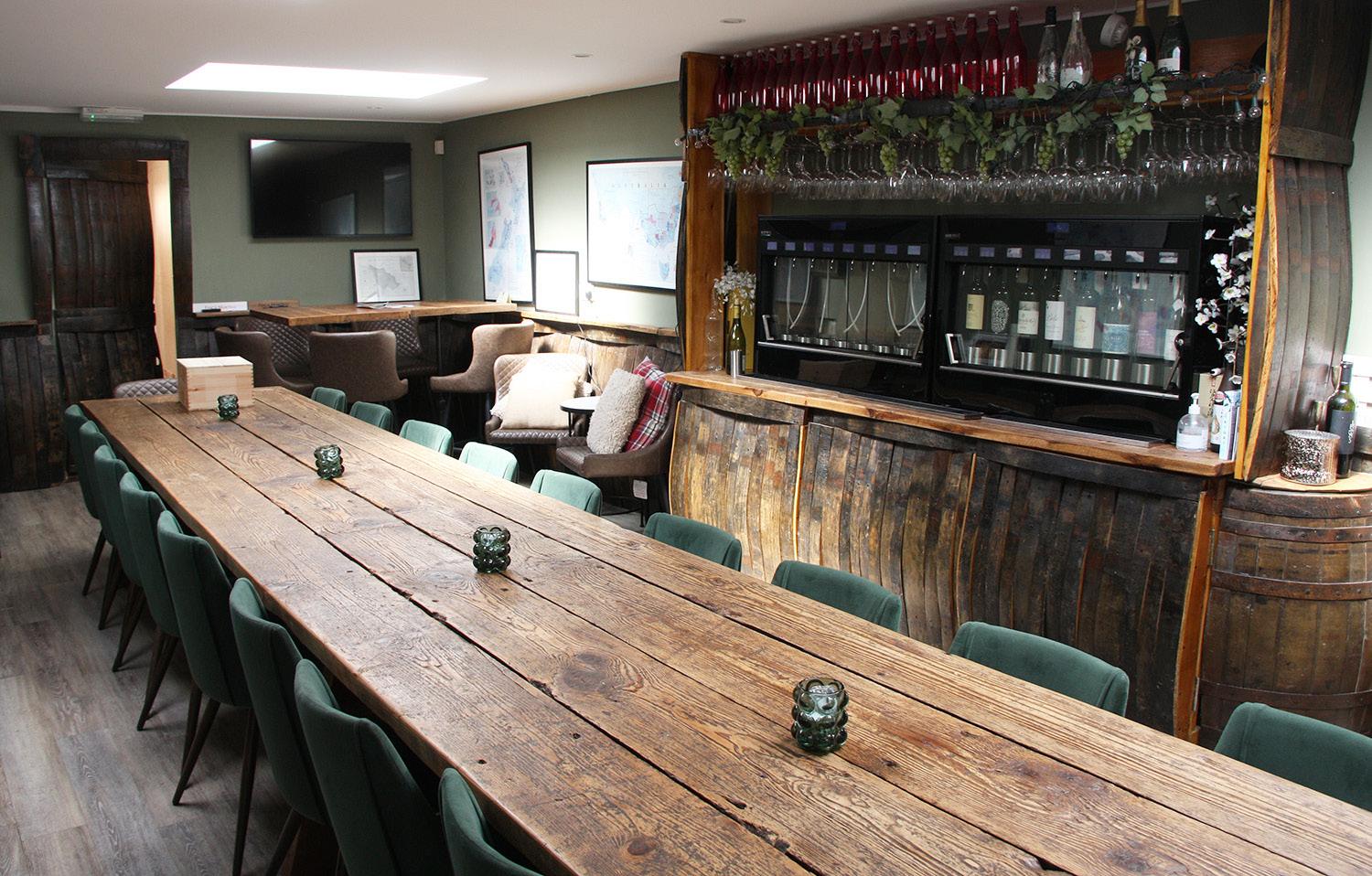

How can I run an ultra-marathon? I’m too injured even to wrap a bottle of wine

Cat’s future cat
At the time of writing, during that week of marvellous sunshine and impressive aurorae, I’m struggling to know how to deal with the last month here. I fell over two and a half weeks ago, badly. A visit to A&E confirmed my fears – a broken collarbone. I’m not going to go into detail about the seemingly endless number of scans and appointments, and the planned surgery that then couldn’t go ahead, but it’s been demoralising and exhausting.
Instead of dwelling on that, let me talk about all the things that need two hands. This includes but is not limited to: putting on jeans, tying back hair, tying shoelaces, using a meat slicer, slicing hard cheeses, wrapping a bottle of wine in paper, moving boxes of wine, writing this article. So yes,
doing my job has been something of a challenge.
I spent a couple of days violating my own (rather lax) dress code at work because they were the only clothes I could get on and function in. The wealth of offers of help that came in from customers was unexpected and wonderful. It has reminded me of the value of our local
communities, and as an anonymous city girl by birth (and I mean real city here, not the elevated status of Winchester that its cathedral bestows) it’s been humbling. The impact on my ultra-marathon training has been disastrous. Simply standing was painful for the first week or so, never mind the idea of running 60km. But, as I am taking a week’s holiday to go to the Scilly Isles to do this race, I can’t really avoid the question: do I even try at this point to get to the start line?
To the great surprise of most, I haven’t written it off yet. Perhaps I just don’t know when to quit, but the same could likely be said of being a business owner. I reckon there’s probably at least half a dozen times I could have done that over the past 12 years.
Of course, I do wonder if this makes me an idiot (it also occurs to me that I possibly spend a bit too much time on selfreflection). All those times that I could have just “walked away”: what would I be doing now? Maybe I’d be finally achieving my life goal of teaching my cat to bring me coffee and a bacon sarnie in bed, or perhaps I’d be an international woman of mystery.
So, I sit here and wonder whether I can sensibly get myself to the start line. I think it’s a given now that I won’t finish this race. The timing cut-offs were always going to be a challenge for me, fully trained. Out of 65 runners last year, only 24 made it back. Running an ultra-marathon isn’t really about finishing (or at least that’s what I’m telling myself), it’s about believing in the “what ifs” and building the mental fortitude to just keep going.
But what is the point of starting if I know I won’t finish? Why put myself through it? Genuinely, I think the mental anguish of watching everyone else start without me would be worse. That said, I also don’t want to be the first person out and on the “boat of shame”.
All those times I could have walked away from business ... what would I be doing now? Perhaps I’d be an international woman of mystery
By the time you read this, my decision will be made. I’ll be in the Scillys and hopefully I’ll be sporting a fully healed collarbone. Wish me luck.
is
Liberty of style. It’s an arresting catchphrase that neatly sums up the very special winemaking culture of the IGP Pays d’Oc. Encompassing 120,000ha of vineyards in a 200km stretch of the Languedoc-Roussillon, running parallel to the Mediterranean from the Camargue to the Pyrenees, the region offers enormous stylistic opportunities to its producers, an almost infinite combination of soils, expositions, microclimates and grape varieties.
It was the latter that was the principal focus of a tasting and lunch hosted by Master of Wine Peter McCombie and The Wine Merchant at London’s Groucho Club in May. As McCombie said in the introduction to a fascinating tutored tasting, the IGP Pays d’Oc is blessed with a remarkable 58 permitted grape varieties, with winemakers able to bottle them with the name of the variety (or varieties) clearly and proudly displayed on the front label, whether the wine is a single varietal or a blend.
The event began with a free-pour tasting of 33 wines that between them managed to cover an impressive cross-section of the IGP Pays d’Oc’s varietal diversity, from Albariño to Viognier and Vermentino (aka Rolle), and from Caledoc to Petit Verdot and Tempranillo. McCombie then picked out “an entirely biased” selection of eight wines which he talked through in detail over a lunch which, as well as providing the independent wine merchants in attendance with an informed overview of some of the most exciting current developments in the designation, also highlighted Pays d’Oc wines’ natural affinity with food.

Cellier des Demoiselles Bourboulenc 2023
An old variety that is planted across the southern Rhône Valley as well as in Languedoc, Bourboulenc may not be the most fashionable of grape varieties –and it’s certainly not the easiest

to pronounce. But McCombie finds a lot to like about it, provided the winemaker takes care.
“A lot of people in the wine trade don’t know Bourboulenc,” he said. “It tends to make wines that aren’t high in alcohol, that you can late pick for flavour, and if you’re not careful it can be a little rustic.”
That’s not a problem with Cellier des Desmoiselles’ bottling, which is made with what McCombie calls a “straightforward stainless-steel fermentation”.
“It’s not an earth-shattering wine, but it’s really delicious and I’d drink it really happily, and that’s what I wanted to pull out of the selection,” McCombie said.
The merchants agreed, with Abi Moreno of Flora Fine Wines in west London appreciating its “grapefruit pithiness”, and Dan Farrell-Wright of Wickhams in Newton Abbot picking up on the low alcohol: “It’s only 11%, but it feels more. You could sit and drink this and it makes it very
approachable.”
“The pithiness is something I found a number of times with the white wines today,” McCombie added. “And minerality and salinity, too, which I’m unembarrassed by as descriptions so long as we accept that they are metaphors, not literal. They bring freshness to wines that aren’t high in acidity.”
Sillages Albariño 2023
According to McCombie, permitting Albariño into the IGP Pays d’Oc family of grape varieties was a “no-brainer”.
“It has a brand identity, like Pinot Grigio or New Zealand Sauvignon Blanc,” he explained. “If you buy Albariño, you know what to expect. Albariño has done a really good job of imposing itself on people’s consciousness, because it’s reliable.”

Peter McCombie MW leads a masterclass celebrating the myriad grape varieties that flourish in the IGP Pays d’Oc

This example comes from one of the region’s most reliable larger producers.
“Foncalieu is a co-op of co-ops – they’re massive, but it doesn’t feel like massvolume wine. They are able to produce wines that have character and interest,” McCombie said. “This one has an immediacy about it. It’s really drinkable, and really accessible and really easy to understand. And while it’s not cheap, it comes in at a really friendly price.”
“It’s very good for a non-Rías Baixas Albariño,” said Moreno. “It’s got expression; it’s fleshy, it has some kind of weight. It would be really nice to do an Albariño that isn’t from Rías Baixas, just to show the difference. We should live in a free, open world; it makes it interesting. Why stick with the traditions? It’s cheap enough to experiment.”
“Albariño is so much more expensive from Spain,” added Farrell-Wright. “That’s a really good price for Albariño. You’re
getting good value for money.”

St Jacques d’Albas
Le Petit St Jacques 2023
Both Vermentino and Viognier have a track record for quality in southern France. But this moreor-less equal-parts blend of the two white grapes “absolutely reflects my bias for Vermentino or Rolle”, McCombie said.
It’s a variety that has developed enormously in recent years in Italy and France. “It does some of the things Sauvignon Blanc does, without being as intensely aromatic, and I think it makes some pretty nice wines as a single variety,” McCombie said.
But it’s also quite interesting as a blending grape, McCombie added, both with Sémillon in the “delicious” Bordeaux blanc-like Domaine la Provenquière P Sémillon Vermentino 2023, and, in this
case, with Viognier, which, McCombie said, makes “an interesting blending partner”. The Vermentino brings pithiness to the Viognier’s full-on aromatic intensity.
“Too much Viognier is too much, and that can make it too thick and heavy and rich,” said Richard Craig of Lubentium in London. “But I’m happy with this blend.”
“I thought it paired fantastically with the food,” added Riaz Syed of Stonewines in Barnet.
Croix de Bonniol 2023
Another innovative blend featuring Viognier, but this time it’s combined with Grenache Blanc, a variety that, as McCombie said, is “clearly Spanish, but the French have done a good job of claiming it as their own”.

“With varietal Grenache Blanc, you have texture and weight and some really interesting wines. And I like the idea of this blend with Viognier. The Viognier is not too much: it’s honeyed, fruity and dry. The Grenache, while it doesn’t have a huge amount of acidity, isn’t flabby, fat or heavy. It has a kind of minerality and salinity that is reining in the Viognier.”
“It’s a nice wine from a grape that is undervalued,” said Moreno.
“I like the fact the producer has been awarded high environmental value status,” added Carlos Blanco, of Blanco & Gomez in west London.

Domaine la Provenquière Pinot 2023
The trend in rosé production in recent years has been for more and more pale-coloured wines inspired by Provence, and there were certainly wines at the walkaround tasting that reflected that development, with Farrell-Wright picking out the Cellier des Demoiselles Caladoc 2023, which he “enjoyed for its subtlety”.
Domaine La Provenquière’s Pinot is an altogether more structured wine, however, and McCombie was happy to select it as his favoured rosé on the day. “There’s a clue in the name of the grape variety: it’s pink-skinned and it’s meant to have some colour,” McCombie said.
“It’s pretty, it has spice and floral perfume. And there is texture, which makes it a more complete wine in my opinion.
“I haven’t talked too much about vineyards in this session, but this is a clay soil on a north-facing vineyard. Maybe that brings some of the minerality you can find in the wine.”

Domaine Combe Blanche Calamiac Terroir Tempranillo 2022
Having already introduced the guests to a successful IGP Pays d’Oc iteration of a Spanish white grape variety, McCombie’s next choice performed the same trick on Iberia’s most famous red grape. “Like Albariño, Tempranillo has been incorporated on a north-facing slope, near La Livinière, a place that is extraordinarily successful,” McCombie said.
“Tempranillo has a reputation for being crowd-pleasing; it’s hard to pick it out as Tempranillo, but it does have nice flavours and people like to drink it. This one uses a small tank, no oak, no punching down, and it’s not a screamer: just a really nice, really drinkable wine.”

The guests were impressed. “If you compare it to a Rioja, it feels like it could be a reserve,” said Syed. “It has a lovely long finish.”
“I like it a lot,” added Moreno. “It’s got all that nice fruit without the clouding of the oak.”
“If I got this in the pub, I’d be happy,” said Craig. “That’s not a high bar, I realise, but by the glass in a pub with a steak and chips … happy days!”
Domaine Ricardelle de Lautrec Cuvée Nature Robert 2022
A grape variety that impressed as a rosé (see above), Caladoc could never be described as traditional.
A crossing of Garnacha and Côt which was bred in 1958 as an attempt, in McCombie’s words, “to make a Grenache that doesn’t suffer from coulure”.

Over the past half century, however, it has begun to thrive in the LanguedocRoussillon, with this “delicious” version coming from vines grown on a terroir of pebbles, clay and limestone.
Relatively low in alcohol, “you get a slightly funky reduction, followed by superdark, black juicy fruit,” McCombie said. “There’s a pleasing rusticity – it’s juicy,
punchy, not heavy. And funnily enough, as I look at the rain falling outside and try to pretend that we might have a summer, this is the kind of wine I’d like to put in a bucket with ice and water for 10 minutes, to cool it off – it would be super drinkable.”
“It’s a nice barbie wine as well,” added Moreno. “And it tastes very different from when I first tasted it. The Côt has brought some black fruit to the party, but there’s some Grenache texture.”
Domaine Les Yeuses
O d’Yeuses 2022
The tasting concluded with another red wine based on a red crossing created in the region in the mid-20th century.

“Marselan is really interesting, a cross of Cabernet Sauvignon and Grenache,” McCombie said. “They were trying to produce something productive with large berries, but it turned out to have small berries. It’s been rediscovered, and the Chinese are going big for it.
“It’s the ripest and most aromatically intense of the reds. It has a fruit sweetness, and 40% new oak.
“But like all the wines in this line-up, there’s a freshness and relative restraint about it that is really pleasing.”

and medical practitioner
“Mike is a fascinating man. Long before it was fashionable, he was championing bottle weights. He moved all his Chardonnay into very strong but ridiculously lightweight bottles about 18 years ago.”
Peter Mitchell MW, Jeroboams Trade

We have been working with Pierro for more than two decades. I’d describe our relationship as more consensual than transactional. We love their wines, we listen to what they want and they listen to our feedback.
Nic is such a lovely guy, remarkably laid back but very focused. He has his own brand, LAS Vino, where he gets to indulge his experimental side, but he won’t change the way his dad does things at Pierro.
The Pierro Chardonnay is the biggest seller; we sell every bottle they let us have for the UK. There’s a huge demand for it in Australia so every year I try to squeeze a bit more out of them.
Mike is very steadfast in what he thinks wine should taste like and he’s not going to be swayed by the latest thing.
As Mike initially intended to plant Riesling, the fact that he produces premium Australian Chardonnay is a very happy accident.

RANGE HIGHLIGHTS



“We are really happy with our relationship with Jeroboams. They distribute high-quality small producers who care about what they do, so it’s a good fit. Nearly everything we do at Pierro is done traditionally by hand.”
Nic Peterkin, Pierro
Dad built up the vineyard from a bare patch of earth in the late 70s to what it is today. He is very much attached to the land and the wines. He actually only gave up practising medicine a couple of years ago, so I don’t think he will ever stop winemaking. It is part of who he is.

Both LAS Vino and Pierro are built on quality but Pierro comes with 40 years of experience whereas with LAS Vino we’re interested in discovery and the thought “what would happen if …?” So that sees us use alternative vessels, discovering unique vineyards, natural ferments and not-so-common varieties.
Pierro is consistent and confident in its approach. Same vineyards each year, same parcels of fruit with gradual evolution from year to year adapting to vintage variation. The wines at Pierro are outstanding, I don’t see it changing under my hand, just slight vintage evolution in the pursuit of excellent wines.

David Williams imagines a new international role with the brief of sorting out the industry’s most pressing challenges
As a curiously bland, shockingly policy-light UK electoral campaign chunters on interminably in the background, I’ve been relieving the boredom of yet another content-free Starmak speech by daydreaming about what might happen if the global wine business had its own elected head of state. Voted by stakeholders working in wine at every level from vineyard to shelf (including the packaging, logistics, and winery equipment sectors), the wine tsar or president (or vineking?) would have sweeping powers to make changes to wine law, with authority above any national jurisdictions.
The job would come with a daunting, tottering stack of an in-tray of existential, urgent and seemingly intractable issues
It sounds like a plum job, one that in my imagination comes with a plush cork-tiled, bottle-filled office and endless “policy discussions” (aka long lunches) in the world’s best restaurants with the world’s finest wine producers.
But if any such position were to exist, the reality is it would come with a daunting, tottering stack of an in-tray – one containing at least three long-term issues that are every bit as existential, urgent and seemingly intractable as those facing whichever middle-aged man in a too-tight suit is given the keys to 10 Downing Street next month.
The first thing any would-be world wine minister would need to get a grip on is wine’s chronic overproduction problem. This has been a sporadic concern for many years now, with different countries expanding and contracting their wine lakes according to fashion and tariff-whim. But the past decade has been particularly acute: according to the OIV, taken as
a whole, the wine industry has been producing on average 11% more wine than it can sell since 2012, an excess of around 2.9 billion litres of wine out of an average annual production of 26.7 billion litres.
The obvious solution is a radical extension to the vine-pull schemes that have taken place in France (notably Bordeaux most recently), California and Australia, offering incentives in the form of subsidies to growers to exit the sector and transition to other crops, with care taken to ensure that any old-vine heritage is safeguarded.
But while this is popular with those who bear the risk of managing and owning vines (ie struggling growers), it’s rather less welcome with the producers, negociants and retailers who buy from them. This powerful group rather likes the status-quo oversupply since it keeps prices low (unsustainably so in some cases) and would fight to keep it.
To pull or not to pull? Depends on who you are most willing to upset (and, of course, who has the most votes).
Candidates will be expected to supply their

Neo-prohibitionism, tax and teetotalism
While the connivance of certain sectors of the wine business is perhaps the most significant driver of wine’s over-supply, the global fall in consumption shouldn’t be underestimated. The OIV’s latest figures show a fall of 2.9%, or 800 million bottles, in wine consumption during 2023, to the lowest level since 1996, the latest chapter in a story of year-on-year decline that started in the mid-2010s.
Soaring inflation and other economic woes in wine’s major markets account for much of the drop: people just don’t have as much money to spend on a non-essential such as wine. A robust campaign to challenge persistent duty rises, and therefore make wine prices more accessible, is a no-brainer for any wine ministerial agenda.
But so, too, is finding an effective way of challenging two other persistent threats to wine consumption: a neo-prohibitionist health lobby with a tendency towards scaremongering hyperbole; and a generation of younger drinkers who are
either abstaining from alcohol of any kind in unprecedentedly large numbers, or, if they are open to alcohol, have yet to be excited by wine. As the kids say, good luck with that!
The single biggest threat to the long-term viability of the wine trade is one that any vine chancellor might feel they have the least power to avert.
The climate crisis, with its multiple extreme-weather threats, and the droughts, wildfires, floods and late frosts that come with them, have made an alwaysunpredictable livelihood all the more precarious – in many cases unendurably so. And it’s only going to get worse.
But if the vast scale of the problem – and the fact that any bid to reach even the most unambitious of the targets set by the most recent COP gathering in Dubai will require the collaboration of governments and industries with carbon footprints several thousand multiples larger than the wine trade’s – that shouldn’t let our industry off
the hook. Indeed, as a high-profile business at the frontline of the crisis, you could argue wine has even more of an obligation to set an example on carbon emissions, and sustainability more generally.
A set of policies aimed at making the wine industry a global leader on carbon emissions and including, among many other things, a complete ban on (nonsparkling) wine bottles above 500g, an obligation to capture and re-use (or sell on) the carbon produced by fermentation, and grants and subsidies for the introduction of solar panels and other renewables in the winery and supply chain, should therefore be an essential part of a wine world election campaign.
In the meantime, and rather than waiting for this daft political fantasy to come true, it might be better if all of us who care about the future of wine and the planet used whatever influence we might have (from lobbying MPs and voting, to putting pressure on suppliers through words and buying deeds) to bring about a green new deal for wine before it’s too late.

Our online tasting gave indies a glimpse of the breadth of Walker & Wodehouse’s range from a familiar region that still has the capacity to surprise
Blanco Reserva 2020 (RRP £34.50)
Reserva 2014 (RRP £74)
According to Walker & Wodehouse key accounts manager Paddy Mallinson, Remírez de Ganuza has been described as “the most well-known Rioja producer you’ve never heard of”. Established by a former wine broker with an intimate knowledge of Rioja Alta and Rioja Alavesa, in the foothills of the Sierra Cantabria, the producer farms 80 hectares and works primarily with old vines.
“They’ve got as many as 240 different
plots, which they will harvest individually, ferment separately, and then go to work with the blending and the ageing,” says Mallinson. “So they’ve got an incredible source of raw material for their wines. If I had to sum up those wines in just one word, it’s really ageability.”


The Blanco Reserva 2020 is a blend of 85% Viura, 10% Malvasia and 5% other varieties, which spends nine months in
French oak.
“The way they make the wines is very traditional, but it’s also very, very precise, clean and elegant,” says Mallinson. “The acidity really shines through.”
The Reserva 2024 is 90% Tempranillo and 8% Graciano, blended with 2% Viura and Malvasia skins, which spends 25 months ageing in French barrique. “And because this is Remírez de Ganuza, the vines are at least 60 years old,” Mallinson points out.
“We list several of their Reserva and Gran Reserva red wines. We started off with just one or two but recently we have shipped some nice older vintages, even some of the fabled 1994, which was their very first Gran Reserva release.”
He adds: “When I was there in October, we tasted some Gran Reserva 2007 which spent 46 months in French oak barrique. The complexity and the length was absolutely amazing, but the wine still retained that freshness and that acidity.
“They’ve got an enormous library of older vintages which we are going to ship and release, I guess with the on-trade in mind but very much available to indies as well.”
Phil Innes of Loki Wine in Birmingham describes the Blanco as “stunning”.
He adds: “I’ve always loved their wines. I mean, everything they do. I’ve never had a dud wine from Remírez de Ganuza.
“The white, for the price, I think is incredible value for the quality that you’re getting. I think it’s bang on trend and exactly what consumers want to be drinking.”
BODEGAS BHILAR
Phincas 2020 (RRP £28)
Phinca Abejera 2017 (RRP £55)
Bodegas Bhilar caught the eye of Walker & Wodehouse just over a decade ago because of the work it was doing to protect and preserve old vines in Rioja Alavesa. “Some of them are very secluded, tiny plots,” says
W&W director of sales Josh Butler. “The last time I was there, we walked into one which was no larger than my living room.”
The business is run by husband-andwife team David Sampedro and Melanie Hickman, who make terroir-driven, garagiste wines from biodynamicallyfarmed vines.
“David is a huge proponent of minimalistic, hands-off winemaking,” says Butler. “He doesn’t have tractors to work his vineyards, he’s got horses. All his estate fruit is foot-pressed and he has a gravityfed winery. It’s essentially him, his wife, his son and a dog, and they make these wines directly from their heart.
“David is a character. If you ever see him around London – he’s over once or twice a year – he’s always got his T-shirt on, which says Rage Against the Machine, and it’s got a plough on it. And that pretty much sums him up.”
The flagship wine, Phincas 2020, is a blend of 75% Tempranillo, 15% Graciano, 10% Garnacha Tinta and 5% Viura, spontaneously fermented in a large oak vat and aged for 36 months in barrel.


“David will put Graciano in anything he can get away with putting Graciano in,” says Butler. “He loves it for its aromatics.” The wine tastes vibrant and alive, with cherry and spice notes to the fore.
Phinca Abejera 2017 is a blend of 55% Tempranillo, 40% Graciano and 5% Viura, again spontaneously fermented and aged in barrique. The fruit comes from a single plot, dating from 1929, and it gives a herbal and heady wine with notes of nutmeg and clove as well as ripe blackcurrants.
“Really distinctive and characterful,” says Andrew Taylor of Taylor’s Fine Wine in Kingston upon Thames, “showing the aromatic character of Graciano.”
Vivanco operates on a much larger scale to the first two producers featured in the tasting. Its winery in Briones, Rioja Alta, includes a museum of wine culture and is something of a tourist magnet. Despite its size, it’s proudly family-owned, with a reputation for making wines that can be enjoyed young.
The Crianza’s intriguing bottle shape is based on a Roman bottle in the museum, a design now patented and unique to Vivanco. The label artwork features other artefacts on display on the premises.
“The Crianza’s sourced from about 20 different plots in Rioja Alta,” says Paddy Mallinson. “The grapes are hand-picked and then stored for 24 to 36 hours in a sort of cold room. That’s just to concentrate those flavours and retain that acidity.”
A blend of 95% Tempranillo, 3% Graciano and 2% Maturana Tinta, the wine spends 16 months in barrel followed by six months in bottle before release. It’s intense and smoky, with sweet red fruit flavours but elegance too.
Antonio Navajas “100” 2015 (RRP £37)
This Walker & Wodehouse UK exclusive was launched to celebrate the centenary of the family-owned Rioja Alta winery, and named after owner Antonio Navajas, who still maintains a hands-on approach despite passing the baton to his daughter Mercedes.
The family works with 150 hectares of vines, 30 hectares of which they own, producing a comprehensive range that runs from Joven to Gran Reserva, taking in red, white and rosé styles.
Vino del Centenario is a blend of 90% Tempranillo and 10% Graciano and, according to Navajas, it’s “probably our best wine – or at least the one that has been made with the most love”. Naturally fermented and aged in a combination of French and American oak, it’s complex and intense, with balsamic and coffee notes and silky tannins. It leaves a lasting impression on our tasters.

Find out more about the full range of Rioja wines available from Walker & Wodehouse by visiting walkerwodehousewines.com or call 020 7449 1665
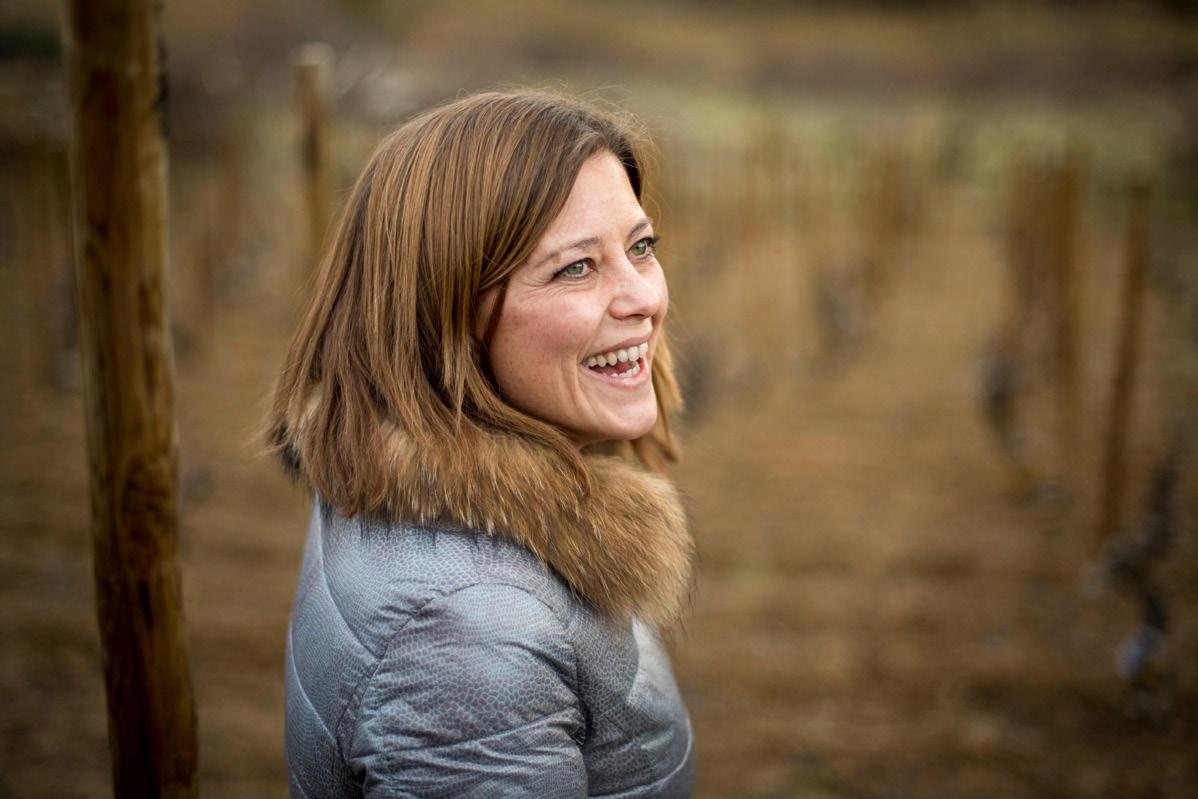
To be honest, a visit to Gil Family Estates could be based in almost any corner of Spain, such is the reach of the business these days. But it feels appropriate that we’re in Jumilla, where it all began, where the craggy Monastrell bush vines seem to relish their eternal battle with the elements.
Juan Gil Jiménez established his vineyard in these parts back in 1916 and now his fourth and fifth-generation descendants are running the show. They’re committed to their spiritual homeland but, under the stewardship of Miguel Gil, the family has established new roots in regions all across Spain. In some cases, this has involved acquisition; in others, such as Licorella in Priorat, the projects have been started from scratch.
There’s no over-arching winemaking philosophy as such; no style template that winemakers in Rías Baixas, Rioja or Montsant are required to follow. But if we are to generalise, the preference is to focus on the organic production of indigenous varieties, typically grown on old vines. Wherever they go, the owners seem keen to invest in the best winery kit they can find, with a particular fondness for optical sorting machines. Sustainability is also the aim.
All told, they now farm 1,800 hectares of land, half of which is in Jumilla.
We arrive at Bodegas Juan Gil, an hour and a half inland from Alicante, and drive to a vantage point 800m above sea level, in a sweeping landscape of rocky limestone plains, fringed by pockets of woodland.
Land is cheap here, and for a reason: there’s

Graham Holter reports back from a buyers' trip to Jumilla and Almansa in the company of Gil Family Estates, which has established impressive winemaking outposts across Spain, working mainly with old, indigenous vines
The preference is to focus on the organic production of indigenous varieties, typically grown on old vines
almost no rain, and the most productive agriculture derives from olives and almonds. The only other viable crop that can survive without irrigation is Monastrell, which sends its roots eight metres into the barren earth in search of sustenance. There’s no problem with mildew or rot in this environment; indeed, the terrain is too challenging even for phylloxera, and so these ancient vines are proudly ungrafted.
Monastrell – known elsewhere as Mourvèdre – is synonymous with Jumilla, accounting for 77% of the vineyard area, and its aromatic, juicy, sensual wines are rightly prized by Gil Family Estates and its local counterparts. But as the world heats up, it’s sensible to spread the risk. As we drive down to the winery, we see trellised vines – many of them white varieties – thriving thanks to irrigation. These vineyards can achieve yields of up to 3,000kg per hectare. Monastrell struggles to achieve half that, and in a drought year the vines’ output can plummet still further. You sense it takes more than just backbreaking work to make it all worthwhile. This is a job you have to love.

Our second day is based in Almansa, about an hour north west of Alicante. We arrive at Bodegas Atalaya and it’s immediately evident that, unlike on the coast, we’re no longer in shorts and T-shirt conditions. The sky is heavy and grey, and there’s a fresh northerly wind, which we feel all the more keenly at 820m above sea level.
As in Jumilla, the land is rather bleak and barren. We hear that as many as 10 ploughs are broken each year as they attempt to tame this unyielding limestone terrain.
We’re greeted by Pepe Sáez, who planned on retiring 17 years ago but never quite got around to it. It was he who planted many of the vines we see around us – most notably Garnacha Tintorera, the local version of the red-fleshed Alicante Bouschet – before building a small winery on the site in 2003. By 2007 he was achieving the sort of critical acclaim that rewarded his efforts. But he needed to sell the business, and thanks to the deal he struck with Gil Family Estates he was able to remain a key part of it. “We can’t imagine this place without him,” says export manager María Dugnol.
Sáez was a pioneer of single-varietal Garnacha Tintorera, which was previously blended away in bulk wine. He also planted Tempranillo, Merlot, Grenache and Cabernet, figuring that their staggered ripening times would make for an efficient harvest season. Climate change wrecked this rather neat bit of planning, and after the Gil takeover most of those vines were re-grafted with Tintorera. Only the Cabernet remains.
We hear that as many as 10 ploughs are broken each year as they attempt to tame this unyelding limestone terrain
Wine producers are usually keen to show visitors the shiniest and most spectacular elements of their production facilities. But export manager María Dugnol is eager to take us to a rather smelly heap of black dirt, which turns out to be crawling with worms.
This is the company’s humus production facility, where vine cuttings and other “harvest residues”, such as lees, meld with goat dung. After six months of fermentation, Californian earthworms are let loose, daily transforming their bodyweight into nourishing humus that can be fed to the vines.
Miguel Gil jokes that he loves the worms because “they work hard and they don’t complain”. But there are serious benefits. Firstly, composting organic matter in this way means waste is no longer burnt, with all the carbon emissions that would entail. Secondly, it means the vines are treated to nutrition that they find easy to absorb – that is, once someone has managed to drill a hole deep enough into the rocks to facilitate the process.

Our two-day trip gave us time to explore the full range of Juan Gil wines, from its wineries right across Spain
Patrick Rohde Aitken Wines/The Wine Press, DundeeThe fresh and aromatic whites, especially the Albariños and Verdejos, stood out as these are what the UK consumer is looking for. The aged Shaya Habis Verdejo [from Rueda] was more to my personal preference but I’m not sure whether the price point would work.
As far as the reds were concerned, my two personal favourites – and probably with the most UK commercial potential – were the young and inexpensive Comoloco Monastrell [from Jumilla] and the biodynamic La Bien Planta Garnacha from Almansa.
Gil Family Estates are a very impressive business. They have successfully grown to become a company that represents the majority of Spanish wine-producing regions in a high-quality and very well-presented way. I also admire their championing of indigenous varieties and their ongoing investment in further growth but also sustainability.
The stand-out quality of Gil Family Estates for me was their real dedication to sustainability and zero waste, with a couple of off-grid wineries in their portfolio, but especially the humus production facility using Californian earthworms chosen for their high productivity. Who knew?

 Margarita Zarenkova Loki Wines, Birmingham
Margarita Zarenkova Loki Wines, Birmingham
I preferred the more entry/mid-level wines. Rías Baixas Kentia has very well-integrated lees, good acidity, and is fresh and delicious.
Shaya from Rueda is subtle, with good minerality. The partial oak fermentation really benefited the structure.
“The standout quality of Gil Family Estates for me was their real dedication to sustainability and zero waste”

La Bien Plantâ from Almansa particularly stood out: fresh and fruity, and well balanced. I love this style of wine and I believe the UK consumer responds well to younger, fresher wines with little or no oak.
Priorat Clar del Bosc: I liked the boldness and bloodiness on the palate, and the grippy tannins. I think it will age beautifully.
I also quite enjoyed the Disfrutando 0.0 sparkling [one of the group’s zero-alcohol wines, which also encompass still styles]. Bright, fresh … everything you need from this kind of wine.
Miguel’s vision is very clear. No expense is spared on important stuff, and the simplicity of the estates is quite charming.
I absolutely loved how clean the wineries were. It was the first thing I noticed when I stepped into any room. You can tell they take very good care of the business, and it transfers into the wine as well.
We were absolutely spoiled for choice, but if I had to choose some favourites they would probably be, in whites, the Lagar da Condesa [Rías Baixas] and the Shaya Habis [Rueda]. As you can probably tell, I like an oaky white!
Among the reds, I liked El Nido and Juan Gil Blue Label [both Jumilla], and La Bien Plantá [Almansa]. Pretty contrasting in style, but perhaps that’s why they were so memorable: they showed off the sheer range of Juan Gil’s portfolio. Blue Label is the perfect example of what they’re probably best known for: fantastic value, big, yet remarkably elegant Monastrells.
El Nido is one of those wines that I've known about for a while but never had the opportunity to try, so it was a real treat getting to taste this for the first time, especially with delicious food to match.
La Bien Plantâ stood out because it perfectly encapsulates their leanings towards sustainable and organic practices. Having it served chilled also highlighted the young and fruity nature of the wine. This, and the Comoloco [Jumilla] altered my perspective of Juan Gil as a winery and acted as a really interesting juxtaposition with the wines I’m more familiar with.
My general impression of the business was really positive. It was lovely to see the respect among the whole team and how passionate they are. It is great that, despite being a big organisation, they clearly have a desire to employ local workers and retain winemakers that know the local area and land. Their investment into sustainable and organic practices, and their continued efforts towards respecting the land, are truly inspiring.

Climate change seemed to be the hot topic while we were there. Despite learning about Monastrell’s hardiness, it’s another thing altogether seeing newly-planted vines surviving in such an arid climate. I was surprised by Juan Gil’s trust in the hardiness of their vines to withstand such stress. Clearly this comes from their intrinsic and generational knowledge of the terroir.

“Wines from the Juan Gil range are all outstanding. The two signature wines, Clio and El Nido, are on another level”Richard Carr Premier Cru Fine Wines, West Yorkshire
We tasted around 50 wines, all of great quality, ranging from around £10 to £100, with some hidden gems not in the UK – which hopefully will change soon.
The pick of the bunch for me were the wines from Castilla y Leon, in particular the old-vine Malvasia, Doña Blanca – wow – the interesting and complex Prieto Picudo and the great value Tempranillo [Gota de Arena], all from the Tridente range.
Also standing out were the wines from Bodegas Atalaya: a mixture of Garnacha and Monastrell, all being well balanced with good structure, and of the highest quality.
Then of course wines from the Juan Gil range, which are all outstanding, from Dry Muscat to the serious old-vine Monastrell range and the two signature wines, Clio and El Nido, which are on another level.
It is always good to visit vineyards, especially when you sell the wines, and I thought the wine and the people matched my perceptions.
The business is focused on channelling its range through a variety of agency businesses rather than a single importer.
Boutinot brings in several of the Juan Gil wines from Jumilla, while Bancroft Wines includes some Lagar da Condesa Rías Baixas wines in its portfolio.
Gil Family Estates is aiming to work with other importers, including independents, to give more parts of its range a UK profile. For information, email maria.dugnol@ gilfamily.es or visit www.gilfamily.es
Vins de Provence ambassador and Irish Master of Wine Ray O’Connor explains that, while Provence has all the natural attributes to make the world’s best rosé, its current success is also down to a groundbreaking project that started a generation ago and united the entire region
It’s not controversial to say that Provence is the perfect place for rosé, or that the art of rosé production has been perfected there. Yet that might imply the region has earned the right to be complacent. Vignerons certainly don’t see it that way.
When Ray O’Connor MW – who spent 10 years of his career as a buyer – first started working with the region, he already knew its rosés were “in a different league” to what he saw elsewhere.
“I wanted to understand how that could be possible,” he says. “Provence has three different appellations – Côtes de Provence, Coteaux d’Aixen-Provence and Coteaux Varois en Provence – and they do a lot to express themselves. So there’s the regionality, in one sense.
“But a lot of what we see from Provence rosé today can be traced back to the 70s, with innovation ramping up 25 years ago. The fact that its success didn’t happen overnight is really a testament to the quality of Provence above anything or anywhere else.”
O’Connor reveals that the research carried out
In association with
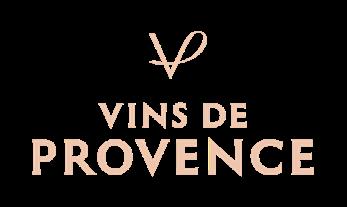
vinsdeprovence.com
at that time began in the cellar, rather than the vineyard.
“They started looking at things like temperature and monitoring and adjusting the extract: you know, how much juice you can get out, how much colour you can get out. And once they’d sorted out the savoir faire in the cellar, they passed that back down through to the growers and the different estates.”
As an outsider, O’Connor is impressed – and rather surprised – at how widely the new advice was embraced by so many growers and producers. It came from Provence’s Centre du Rosé, the only research and development centre in the world devoted to rosé wine.
“It involved things like changing from gobelet bush vines to trellis, so that they could use mechanisation, harvest at night and maintain the freshness. It happened at a time when they weren’t chasing, they were leading. None of us knew; I certainly didn’t know about this. But they were just chiselling away, driving quality.”

As well as challenging themselves to improve on a winning formula, Provencal rosé producers were – and are – looking at ways to cope with a changing climate, and to work more sustainably.
Nathalie Pouzalgues, project leader at the Centre du Rosé, typically analyses around 1,000 rosé wines every year, from France and beyond.
“She tracks the colour, she tracks the abv, the pH, the total acidity, and the residual sugar,” says O’Connor. “She’s shared the graph to show how things have moved over the past 20 years. But very
interestingly, the pH and the abv of Provence rosé have not shifted, when, of course, we know that the temperature has increased.
“They’re managing to achieve physiological ripeness earlier, so that they can pick earlier and maintain the same pH and the same abv over these years of extreme heat.” That’s why Provence rosé can still achieve its trademark pale colour and freshness: “Those are a critical part of its success story, in my opinion,” says O’Connor.
Provence is not the only wine region to make claims about its commitment to nature, but O’Connor is convinced that its words are matched by action, and on a grand scale.
“I wouldn’t ever allow greenwashing,” he says. “And if I hadn’t seen as much as I saw myself, I wouldn’t say it. But it’s so environmentally-driven down there, thanks in part to the Mistral.” This wind helps keep vineyards dry and healthy, and free of mildew. “The figures say 24% is organic, and the national average is 17%. All told, 57% of Provence vineyards are organic and/or HVE [high environmental value].”
Integrated pest management is a hot topic, encouraging ecosystems that support bird and bat populations, along with other wildlife, to naturally control insects and aphids.
“There’s quite a lot of co-habiting vines and

woodlands,” says O’Connor. “That’s what keeps a very healthy biodiversity.”
Regenerative viticulture is also high on the Provencal agenda. “So basically, just keeping the soil healthy,” says O’Connor. “Most vineyards now have cover crops either in every row or every second row. That’s managing hydric stress and also putting nutrients back into the soil.”
It becomes clear that the emergence of Provence as the world’s pre-eminent rosé wine is the result of decades of analysis, toil and persuasion – not merely clever marketing. As O’Connor says: “For something so Instagramable and so popular, it has a much greater depth to it.”

All Provence rosés are not alike
The region’s three appellations and what each has to offer
Côtes de Provence
Example wine: Château Montaud, Côtes de Provence Pierrefeu 2023
“In Côtes de Provence there are five DGCs [Complementary Geographical Denominations]. These are basically crus, or sub-zones,” says O’Connor. “They differ in style somewhat. In Pierrefeu we see both maritime and continental influences, giving a fullness and roundness to the wine, while still maintaining great freshness. In contrast, another DGC, Sainte-Victoire, is further over in the west, and that is far more mineral, vibrant and linear.”
Coteaux Varois en Provence
Example wine: Estandon, Reflet 2023
“In Coteaux Varois en Provence I think 46% of production is organic; this one is HVE, so it’s more



about biodiversity, protection of the soil, flora and fauna integration. This appellation is tucked into the mountains, so it has a bit more freshness to it. You wouldn’t say lighter, but a little more vibrancy or tension to it, perhaps. I find the wines are consistently well focused, and I think that might come down to the viticulture as well as the terroir and how well they’re taking care of the land.”
Coteaux d’Aix-en-Provence
Example wine: Château Paradis 2023
Bordered by the Rhône and Durance rivers, Coteaux d’Aix-en-Provence rosés typically shimmer with distinctive salmon-pink, peach and lychee colours.
“The varying climatic influence in the area, including the Mistral wine descending from the north, give this area a nice breadth of character overall,” says O’Connor.


The wine merchants who commission artists – or even members of their own team –to create illustrations of their shops, dogs and delivery vehicles
Rupert Broadley at Hattersley Wines uses a combination of AI and Photoshop to create bespoke images in an illustrative style. The pictures, which have become a feature of Hattersley’s social media, usually feature Chase, the canine face of the company. Rupert says he knows he’s got the artwork right if Chase looks good.
“Customers enjoy the images and, as wine shops can be intimidating if people don’t know you, these pictures present a softer, more approachable side to us,” he says.
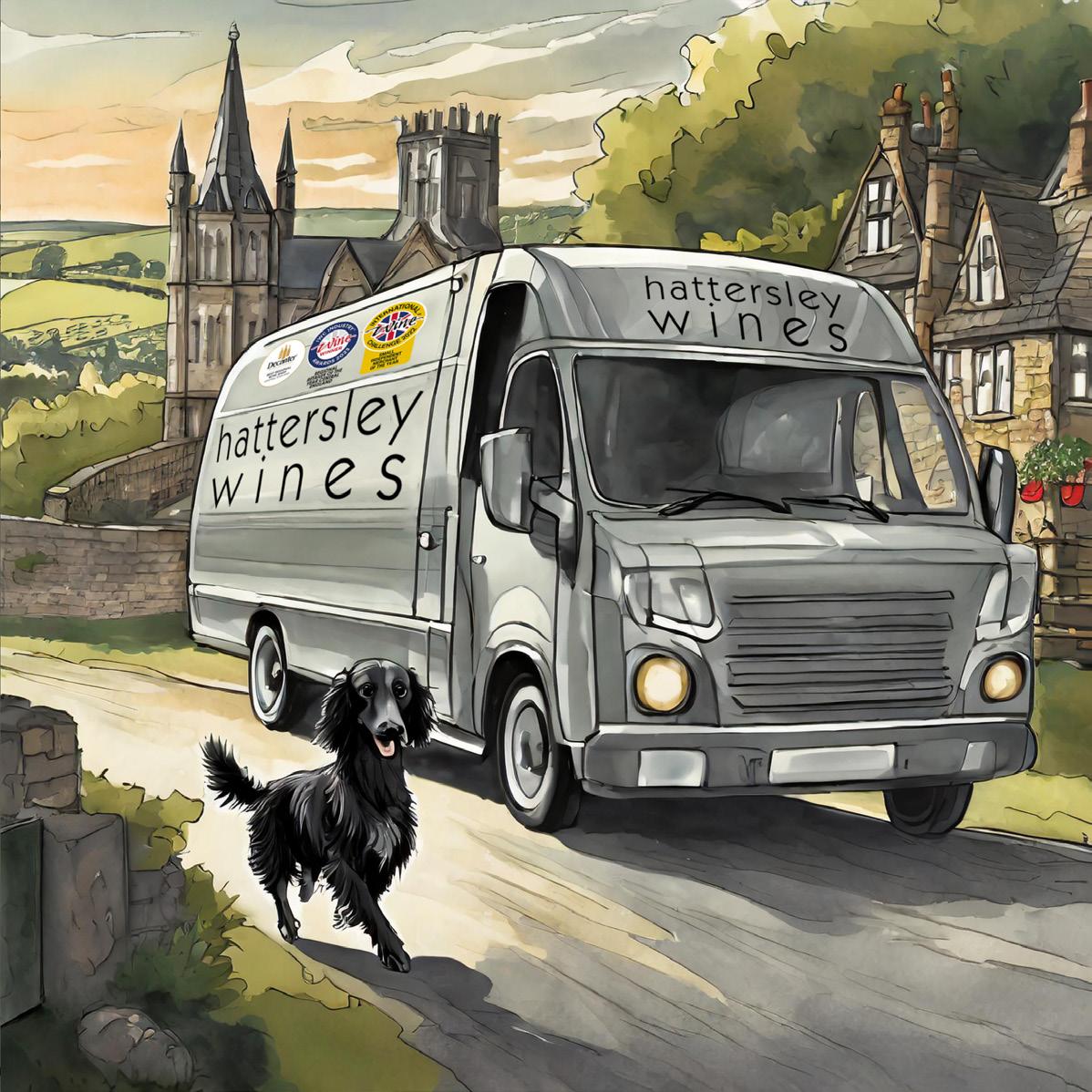
In addition to producing the illustration for this characterful shopfront, artist Megan Rebecca also creates blackboards for owner Brian Saunders to display in the shop.
“Megan is the daughter of a customer and I know she studied illustration at Oxford Brookes,” he says. “We love her work and when Megan creates a blackboard for us we try to keep it for as long as possible, because they’re so much better than the ones I can do.”
Megan reports that “it’s still one of my most popular pieces, with lots of customers ordering prints of it”. See more of Megan’s art at meganrebecca.co.uk



Owner Hal Wilson says: “The painting is by local artist Ann Priddy, whose main focus is depicting local scenes in a colourful and contemporary style. Our shop is in a beautiful Georgian building overlooking the iconic King’s College, and it presented Ann with an ideal subject for her work.”
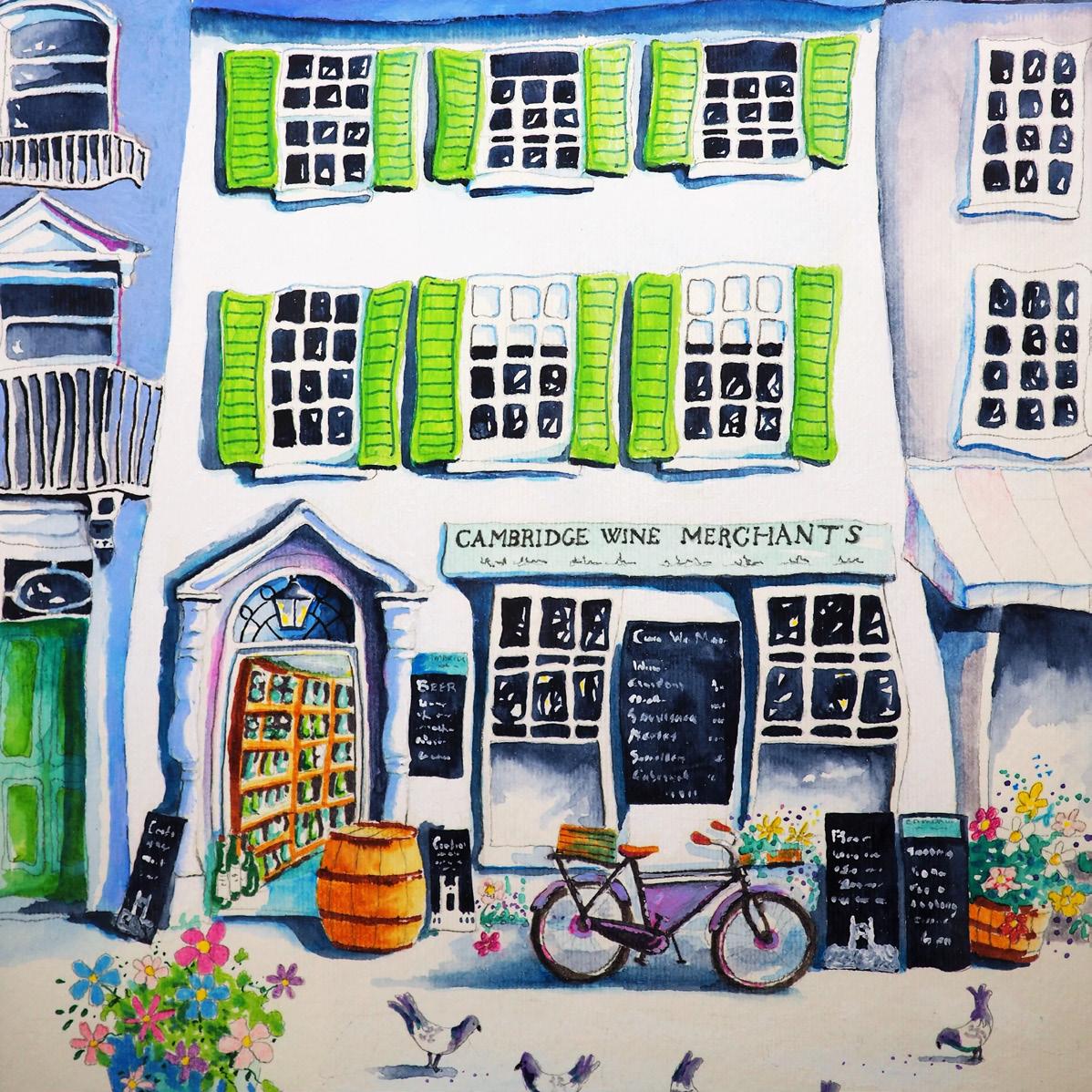

Artist Christine Hodson is a friend of owners Benoit Dezecot and Sarah Ross. Anyone who is familiar with Christine’s work will recognise her penchant for black cats, which often make an appearance in her paintings. “Christine approached us and asked if she could paint the shop and she did one of our restaurant as well, which she gave to us as a gift,” says Benoit.


What’s your bestselling Champagne – and why do you think it does so well?
Our best seller is René Jolly Cuvée Speciale NV – probably because we recommend it! It’s not overly expensive, it’s in the medium range [£49.99] for price, but the quality for the price is great – it’s like you’re tasting a £100 or £150 Champagne. We get it from Awin Barratt Siegel, but it’s not one that you see very much.
In total, we have seven Champagnes –our cheapest is £38 [Lavergne Champagne Brut], and the most expensive is £124.99 Veuve Clicquot [magnum].
What about sparkling wines?
Kimera Amphora Pét Nat Ancestral NV, an amphoraaged sparkling Garnacha, a rosé from Navarra, which sells for £24. We get it from Moreno. I think what people like is the freshness of it – it’s light with a hint of fruit, not your yeasty flavours. Less complex, easy drinking. The fact it’s amphora-aged brings out those flavours.

What’s your own favourite fizz?
I don’t really drink the stuff! But we do get some in from Portugal, Távora Terras do Demo, and they’re so good for the price – a rosé for £21.65, and a white for £19.80. And we’ll open that whenever we’re having cod.
Have you noticed an increase in sales of sparkling wine in recent years?
There are peaks and troughs. We sell bucketloads at Christmas, but otherwise it drops right down. We get a few days of nice weather, when we sell loads of rosé and Prosecco because that’s what people think they should drink when the sun’s out, but otherwise I haven’t noticed a big change.
Veneto IGT, Italy
This sparkling wine is an intense ruby red with purplish highlights. The bouquet is intense and elegant with hints of Morello cherry and wild berries. The wine is dry and full bodied with nuances of red fruit. Good balance and acidity. Excellent as an aperitif or with pork, cheese or dessert.
Azienda Agricola Trevisana is a small winery owned by the Tombacco Family in Paese, in the heart of Veneto. Trevisana’s vines are cultivated in a 100% organic method with power generated from solar panels. Combined, this guarantees a product of naturally good quality while respecting the environment. Tombacco holds Equalitas certification for sustainable wine growing.
Lanchester Wines RRP £12.99

CHAmPAgNE
Champagne, Côte des Bar
Ample nose with hints of red fruit and the forest floor. Full-bodied palate with good persistence and excellent balance with spiced red berry fruit flavours. Vinification via the skin contact method which creates the beautiful soft pink colour. 36 months on the lees in Moutard’s chalk cellars. Serve at 12°C with salmon, red mullet or grilled meat.
The Moutard family respects its ancestral land where it has grown grapes for eight generations. The family’s knowhow is in keeping with tradition and consideration for the vineyards’ ecosystem in order to ensure handcrafted and sustainable viticulture.
BALLANCIN PROSECCO
SUPERIORE CONEgLIANOVALDOBBIADENE DOCg
Conegliano-Valdobbiadene, Treviso, Italy
Extra Dry. A perfumed nose of citrus and strawberries with a hint of toasty complexity. The palate displays upfront flavours of lemon and lime, mingling amongst red berries and honey. Time on yeast lees post ferment has resulted in a beautifully creamy palate with tremendous length of flavour.
Lino Ballancin purchased the land from the Brandolini counts in the 60s and planted the original vines. His two sons, Sergio and Antonio, spent a lot of their childhood working these vines and perfecting the craft. In 2012, Lino was appointed Knight of the Republic and today his two sons still work together to produce outstanding wines and Prosecco.
Lanchester Wines RRP £14.99

DOmAIN
Lanchester Wines
RRP £39.99

Vin de France
A delightfully lively wine with a subtle aroma of red berries and delicious tartness on the palate. 100% Pinot Noir, this is a beautifully dark pink colour in the glass and it works perfectly with ice creams or a palate cleanser at the end of a meal.
Several years ago, the Moutard family purchased a domaine in Burgundy and began producing a range of interesting offerings, including Pétillant-Naturel – and the Pet’ Mout’ range was born! So, why a flatulent sheep on the label? The name is a play on words: it could be an abbreviation of Pétillant Moutard, or an alternative is Péter Mouton (French dictionaries at the ready!). Even serious wine can have a bit of fun.
Lanchester Wines
RRP £15.99
CHAmPAgNE mOUtARD gRANDE CUVÉE BRUT
Champagne, Côte des Bar
A bright Champagne with a juicy mix of black cherry and candied pink grapefruit. This cuvée is the pillar of Moutard’s production. Refined, rich nose which evokes notes of butter, almond and brioche. Lively, elegant and balanced palate with good mouth feel. Made with 80% Pinot Noir, 20% Chardonnay from vines an average of 20 years old. Available in a range of sizes from half through to jeroboam.
The Moutard family has been making wine since 1642 from its base in Buxeuil on the sunny slopes of the Côte des Bar and started producing Champagne in 1927 when Lucien Moutard took over the family vineyards. Today his children François, Véronique and Agnès run the business.
Lanchester Wines RRP £34.99 (75cl)

London, England
The nose is fruit-driven, with primary red berries and ripe apricot. On the mouth, this has a fizzy freshness with a sherbet, stone fruit flavour and a textured finish from skin contact.

This is a low-intervention wine and, from next year, grapes will be sourced from the Foxhole vineyard, formerly part of the Bolney Estate. This wine isn’t produced every year (the next vintage will be a still wine).
Tucked away down a little alleyway in SW6, London Cru, the UKs first urban winery, is based in an old Victorian warehouse which was once a gin distillery. While the surroundings are historic, innovation is at the core with house precision temperature-controlled tanks and state-of-the-art winemaking facilities.
Lanchester Wines RRP £28.99
 TREVISANA BIO RABOSO fRIZZANTE
LONDON CRU PINOT gRIS SPARkLINg ROSÉ
mOUtARD ROSÉ CUVAISON
mOUtARD PET’ mOUT’ PÉTILLANT-NATUREL ROSÉ
TREVISANA BIO RABOSO fRIZZANTE
LONDON CRU PINOT gRIS SPARkLINg ROSÉ
mOUtARD ROSÉ CUVAISON
mOUtARD PET’ mOUT’ PÉTILLANT-NATUREL ROSÉ

What’s your bestselling Champagne – and why do you think it does so well?
The only Champagne we sell is one we bring in ourselves: Elodie D Champagne Cuvée Pierre NV. Elodie is the lady who runs the Champagne house, and it goes with what we call the café – Elodie’s.

The name of the house changes over the years, with the different winemakers – and all of the winemakers have been women. It’s in Épernay. We sell it by the glass, and it goes down very well. We buy on a reasonable scale, so it would be counter-productive to sell other brands when we’re keen to sell our own Champagne.
What about other sparkling wines?
We do some English, some Prosecco and Cava and the like. Probably the bestselling is Prosecco in the café, but for retail it would be English. We’ve rotated what we stock over the years. Right now we’re doing Nyetimber, Exton Park and a couple of others.
Have you noticed an increase in sales of sparkling wine in recent years?
I couldn’t say for sure. I’ve had this business since 2019. Before that, I had a business in Darlington, and we sold boatloads of Prosecco. But that was much more on-trade, and on a cheaper scale, so it’s hard to compare.


What’s your bestselling Champagne – and why do you think it does so well?
Because [Champagne] is not that big of a seller for us, we only sell one Champagne, which we get from Roberson – Henri Dosnon. We were selling Irroy from Enotria and that went out of stock, and we were looking for a replacement, and we just liked it [Dosnon]: it’s smaller production, approachable, not too fresh but not too toasty, quite a good price, and we met the guy and we liked their story.
What about other sparkling wines?
We have an Italian, Bolé from Enotria&Coe, which is more like £14, from Emilia-Romagna. It’s a bit more flavoursome than Prosecco, and there’s a park round the corner called Bole Hill, so people love that. We also do well with Fowles, which is also from Enotria&Coe – it’s an Australian cross between Champagne and Prosecco, and it’s the next step up.
Have you noticed an increase in sales of sparkling wine in recent years?

Generally, people love it, it’s quite popular, and there has maybe been a slight uptick – it’s definitely not going down. I think people are less likely to know what they’re looking for with sparkling wine. They’re familiar with Prosecco, but they are open to trying something different – maybe less than they are with other wines, although that may be because our sparkling range is small.


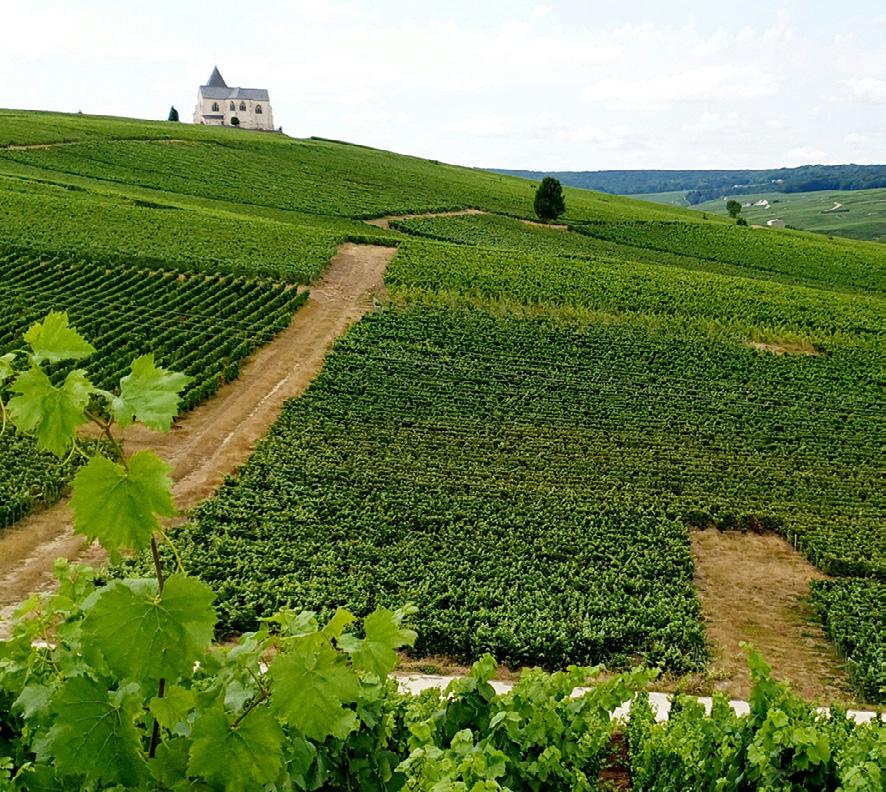





What’s your bestselling Champagne – and why do you think it does so well?
We don’t stock a lot of Champagne; we have three in total. We have a Waitrose round the corner so we don’t have any of the mainstream brands. Collet Brut Rosé [from Hallgarten & Novum] is the bestseller. I think that’s just because it’s not one of the big-name houses, but it’s good value for money as it’s still around the same price as the big names.
I would say Tinwood Blanc de Blancs (from West Sussex). A lot of people come in and ask for recommendations for wines to have with fish dishes, and the Chardonnay-only style, with a bit more
sharpness, works well for that. We’ve also just taken on Raimes, and we went with that because the people who make it have been farmers for generations and they’re more interested in making an expression of their land than they are in making loads of money. Also, it does taste really good.
Some of the West Sussex ones are very good but there’s something about Hampshire: people want something that’s only half an hour from here.
We’ve got a lot of quite savvy people here who like a crémant, so we stock three and people understand it’s a traditional-method wine but it’s not from the Champagne region. [Our customers] also understand the difference between Cava and Prosecco and so Cava does very well for us.
The bestselling crémant is Dopff au Moulin Crémant d’Alsace Cuvée Julien [Hallgarten & Novum] which might be down to me pushing it – it’s a great value wine. I always tell customers, when they’re looking to buy crémant, under £25 you get really good value for money. Another wine that does well for us at £20 is Émilie Laurance [from the Loire], which we get from Jackson Nugent – it’s £20.
I always tell customers, when they’re looking to buy crémant, under £25 you get really good value
What’s your bestselling Champagne – and why do you think it does so well?
At the moment, we do a lot of Joseph Perrier [Jeroboams] and a lot of Moutard [Lanchester Wines], which are at different ends of the price spectrum. They are more Chardonnay-based –lighter, fruitier – which is the opposite to my own taste, which is more Pinot Noir. But the market up here is for more accessible Champagnes, fresh and fizzy – it’s not a complex market.
The Joseph Perrier does it for people because it looks like a premium product, a brand people will have heard of, especially if they’ve been to France, but it doesn’t have the Moët/Veuve ubiquity, so it has some exclusivity for us in our deli and restaurant, and also for branding up our garden. We’re the only Joseph Perrier garden in town!
What about other sparkling wines?
We sell a lot more Prosecco. It’s quite a wealthy area, but there are Champagne tastes and Prosecco pockets. We sell a lot of Moutard’s crémant: it looks like Champagne, and it works well for people who want something that doesn’t say Prosecco. And we have a nice South American one, slightly pink, [Casa Boher Extra Brut, from Mendoza] from Ucopia, which does very well.
Have you noticed an increase in sales of sparkling wine in recent years?
There is always an excuse for fizz. I used to work in London, and we sold a lot of Champagne. Up here we sell a lot more Prosecco. I’m not sure if that’s a matter of geography, or changing times.
 Vines on Santorini
Vines on Santorini
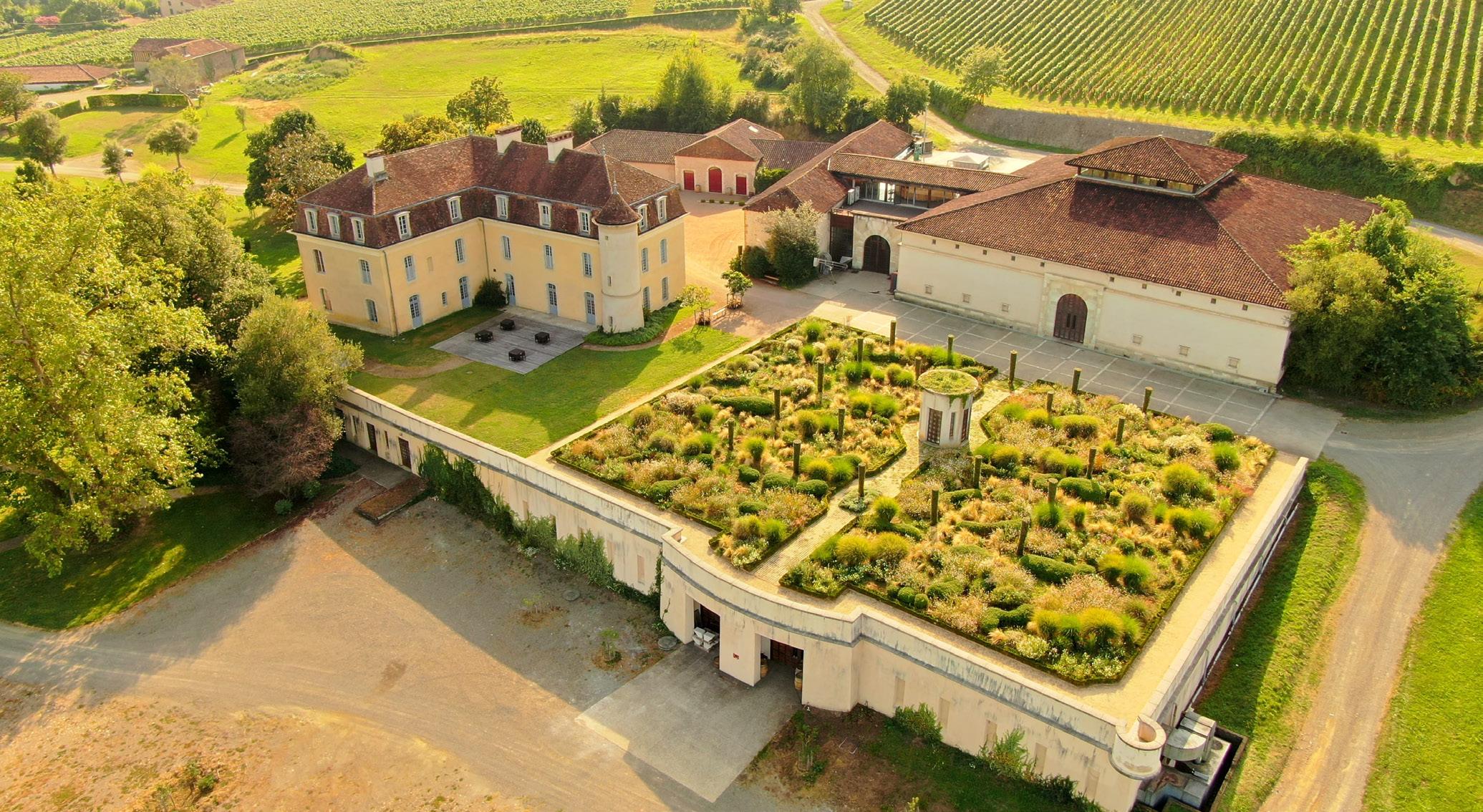
Antoine Veiry, stepson of the legendary Alain Brumont of Châteaux Montus and Bouscassé, is taking the family business into new territory with elegant wines that not only reflect their terroir but are ready for immediate drinking
If you’re an oenophile with the memory of an elephant, you might remember interviews with Alain Brumont. This entrepreneurial winemaker from Madiran in the south west of France has been described by some as tricky to interview or, more flatteringly, “France’s Angelo Gaja” and the “bull of Madiran”.
Now in his seventies, Brumont has cultivated a loyal following for his critically acclaimed wines from both Châteaux Montus and Bouscassé. Even for those who know him only by what they’ve read, it feels as though his shoes are going to be challenging to fill.
Enter Antoine Veiry, who was recently in the UK to talk all things Madiran, Pacherenc du Vic-Bilh and Tannat. Antoine is Alain’s stepson, arriving at Montus when he was nine years old. By the time he was 14 he had declared his intention to commit to the family estate. Three years later he was taking up winery internships across France, and further afield in Australia
and Oregon. He returned to Madiran in 2018 and, though he has no formal title, “wingman extraordinaire” feels about right.
It takes just minutes to understand that Antoine isn’t a mere follower, but capable of making notable footprints of his own. He’s engaging, smart, focused, evidently blessed with nerves of steel, and a formidable work ethic.
“We [Alain and Antoine] are passionate about the place, the grapes and the terroir we work with," he says. “We want the wines to have a modern feel, to be accessible and ready to drink when they are released for sale … we want to reengage and connect with the UK market.”
Inspired by lessons learnt at other wineries, Antoine has made changes to the winemaking. “We do longer maceration now, but slower and softer extractions. I want the wines to be as elegant as possible. We are much more observant than before, doing tasting and analysis more often during the winemaking process. We have
a microbiologist on site who supports our analysis and helps us make the best decisions on the wines.”

The intention is to be as hands-off as possible, but Antoine is clear that this is only achievable if there is the chemistry and analysis to give them confidence to leave well alone.
Antoine is fortunate that his stepfather seems to have a nose for plot selection, and they now have some of the finest sites in Madiran to work with. Massal selection and carefully selected clones play an important part, as does attentive viticulture: judicious planting density according to variety and clone, leaf management, green harvests and hand harvesting.
As our interview goes on, the curiosity to get tasting intensifies. But first, how would Antoine describe Brumont wines? “Our wines reflect our place, its terroir, and our gastronomy,” he says. “Our grapes, like Tannat and Petit Corbou, can make great varietal wines, like Merlot in Pétrus, for example. They are ageworthy and complex, and amazing food wines. They are unique and, yes, best hand-sold.”
Antoine goes on: “It is true that some people who know and love our wines don’t always know where they come from. Sometimes the easiest way to sell Madiran wines is not to mention Madiran.”
Indeed it is noticeable that some of the premium wine labels make no reference to the region, or even the grape variety. This makes the articulation of the Montus and Bouscassé brands hugely important.
Château Montus is home to Brumont’s most premium wines. This vine-less property was purchased by Alain in 1980, and quickly planted with 18 hectares of vineyard. Here the soils are pebbly and akin to those found in Châteauneuf-duPape. Château Bouscassé was the family property, taken over by Alain in 1979. Many of the vineyards here are planted on clay-limestone and grès soils in the commune of Maumusson-Laguian. Their different terroirs offer the opportunity to make a stunning spectrum of wines.
Bouscassé Les Jardins Philosophiques Pacherenc du Vic-Bilh 2018 epitomises much of the Brumont ethos. It’s a five-yearold white made from Petit Corbou, aged one year in concrete tank. High density
plantings support the wine’s texture and density, as well as moderating the wine’s naturally high alcohol. It’s an impressively structured, oily, preserved citrus white. A foodie wine if ever there was one.
By contrast, Montus Blanc Sec Pacherenc du Vic-Bilh 2015 spends three years in large oak barrels and wooden casks. It has amazing concentration and evolution, with pristine acidity. It is a white wine without peers, though it draws natural comparisons with the great whites of Burgundy. It’s singularly delicious.
Château Bouscassé Rouge 2018 (new label) and Château Montus Rouge 2018 are both Tannat-led, with the first the more supple of the two. Antoine explains that his winemaking in both reflects a move towards greater elegance in the wines, with no loss of Tannat’s richness and intensity. The Montus sees 30% to 50% new oak and has deeper tannins. Both wines cry out for the hearty cuisine for which the south west is famous.
Château Bouscassé Vielles Vignes 2016 is made from fruit picked from 120-year-old vines in a 1.5-hectare single vineyard, with terroir that resembles Bordeaux’s Right Bank. Antoine says he loves this wine because the quality of the grapes makes the wine itself – a glorious mouthful of earthy dark fruit with benchmark freshness.




Montus XL 2016 comes from a single plot on the estate and honours the regional tradition for extended ageing of Tannat.
Alain Brumont ages the wine for 40 months, starting in 225-litre oak vessels followed by three years in foudres, and it emerges with impressive elegance and energy.
Montus La Tyre 2008 is another singlevineyard Tannat. West-facing and at 320 metres, this is the last plot to be harvested. It’s a delight to taste because it shows the inarguable quality and longevity of Tannat. It is a curious idea that wines, especially with history like those of Brumont, should be described as modern to secure their consideration for wine buyers. Brumont is evolving, as all the great estates do. Its wines have qualities and character that you’d be hard pushed to find elsewhere. The modern drinker would be foolish to miss them.


David Williams quizzes merchants about their Italian ranges in an attempt to find out which wines from the country work in the independent sector –and which ones leave customers scratching their heads
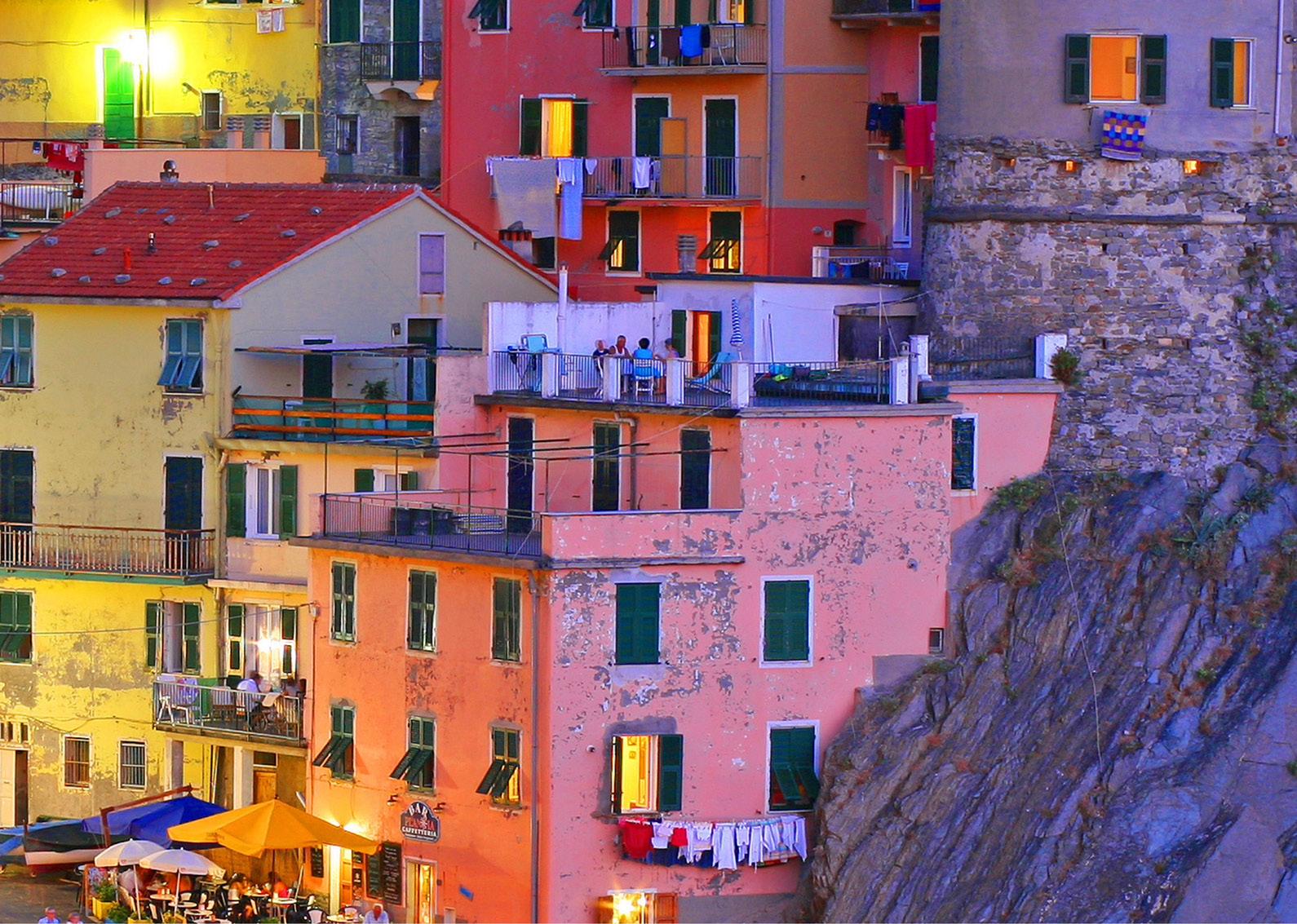
Tell us about your Italian range and how it fits in to the broader mix.
We have a core of 10 – five whites and five reds, then we have another 10 or so of the slightly more exotic stuff that doesn’t sell. Our sales are more in the £8 to £12 range, and we do quite well with the good middle ground. But we’re not really one of those posh hand-sell type merchants.
What kind of regions, styles or grape varieties do well for you from Italy?

We do nicely with Pecorino and Montepulciano, and very nicely with a red and white we get from Buckingham Schenk: Tenuta Tomasella Cabernet Franc and Chardonnay [from Friuli Grave]. They’re £12 or £14 and they are really good for the money. The Chardonnay is really good value when you think how crazy prices have got in Burgundy. We also buy from Barton, Brownsdon & Sadler and we get quite a bit of Catarratto from Boutinot. These days we do more Pinot Grigio from Hungary, where the prices are better.
How well do you think your customers understand Italian wine?
We tend to recommend wines at a price point, and there’s no resistance to Italian wines: they [our customers] buy what we have and what we sell them, and they’re not too fussed by the regions, although we do have some customers who will come in just for Italian. [In general], the public are slightly confused by Italian wine, but Primitivo and Montepulicano are certainly understood.
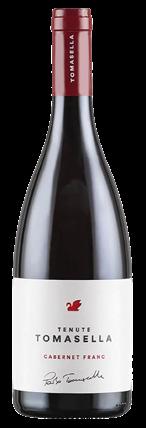
Tell us about your Italian range. How many wines do you have?
We are looking at 139 products listed. Some things we only do wholesale-wise, but we do like Italy; we feel as an indie that people can come to Italy confidently.
What is it about Italy that inspires confidence?
It boils down to diversity and being able to hit a lot of customers with the same country, whether that’s entry-level wines for people who are at the beginning of their wine journey – wines that are fruit forward and have softer tannins – or wines for people who are really grown up and who, when they’re not drinking Italian, are drinking fine Burgundies.
There’s also a really good range of pricing. There’s plenty of stuff under a tenner, all the way through to wherever you want to go to.
What styles of Italian are doing particularly well for you?
We feel Italian white wine is life after Sauvignon Blanc; customers are going back to Italy. Monte Schiavo Verdicchio dei Castelli di Jesi, which comes in through Third Floor Wines, outsells our New Zealand Sauvignon – the Savvalanche is over! To be fair, that one hits a pound under its nearest rival in New Zealand. But it’s a balanced style with lovely fruit and great quality winemaking. It happens to be organic, which is not why we bought it, but that ticks a box for some. It’s one of those wines that delivers a lot more bangs for bucks. When we first listed it, it went in a lot of baskets, and it’s stayed popular.
We’re also getting really excited about Verdeca – Alice Verdeca from Produturri di Manduria – and a single-vineyard Verdicchio, Zaccagnini Salmàgina Verdicchio. And the latest addition is a Zibbibo, Rallo Al Qasar Zibbibo from Sicily, one of the most dynamic wines we’ve had in years. I’ve sold it all – it all went in one weekend.

Where are you sourcing these wines?
Those three are all from Alliance, but we’ve got a lot of suppliers that go into our Italian range: New Generation, Liberty, Alliance, Boutinot, Third Floor, Milestone Wines …
How about reds?
Our best-selling red is also an Italian, Baglio Gibellina U Passimiento from Alliance. It’s a style which we wouldn’t necessarily drink ourselves anymore, but which is now putting itself into the mainstream. It’s what people seem to go to when they’ve done Rioja and done Malbec; appassimento is the next step. About two years ago, appassimento wines made it into the supermarkets after being dominated by the indies. It’s a wine style that ticks a lot of boxes for fans of big red.
And beyond appassimento?
We get through a barrel load of Primitivo, and an incredible amount of Nero di Troia, particularly one called Canace, a heavy-bottle job from Liberty. We sell as much of that at 24 quid as we do from the rest of the world at half the price. Obviously, we still do wines from Barbaresco and Barolo, and we are delighted to have something from Valtelina. We are also hunting down the Amarone style of Nebbiolo from Valtelina.
Do you ever sense any confusion from customers about Italian wine?
We are in the fortunate position of being a destination site, rather than a passing site –and customers already know what they’re looking for. And if they don’t know, it often ends up being Italian. We sell more Italian than any other country, with the possible exception of France.

 Clive Barlow MW
Clive Barlow MW
What does your Italian range look like?
We’ve got 40, which makes up about 20% of the whole range, so it’s a big deal for us.
And which wines do you find perform particularly strongly?
Probably our best-selling Italian is a wine we get from Bancroft [Ca’ Vittoria Apassimento Negroamaro Primitivo], which is riding that wave of appassimento wines – wines that are that bit riper, richer, and more alcoholic.
The consumer likes that accessibility and the ripe fruit flavours, although there’s a degree of complexity in this wine: it’s drier, and more grown up. It also retails under £14, so it’s very accessible. Our average retail price is around £15, and so £14 makes it affordable, a midweek as well as a weekend wine. Plus, it’s very food-friendly – something the staff can sell.
Do you have any other appassimento wines? The style seems increasingly popular. In the red styles, we do a couple from Alliance. There’s one from the Veneto [Mabis, Biscardo Neropasso], which includes some Cab Sauvignon, and one from Nerolo D’Avola from Scily with a bit more sugar. That bit of sweetness really mimics what you’d find in wines from Australia, and quite a few from California, but I love the fact we’re not talking about Cabernet, Merlot, Shiraz … we’re talking about something different. We’ve also had a white appass’ style which we sourced from the local wholesaler, which gives the Grillo from Sicily a bit more weight. Customers really like the richness.
And how about beyond appassimento – are your customers still interested in classic regions such as Piedmont for example?
In Piedmont, we have Barbera d’Asti and Langhe Nebbiolo – they can deliver a lot of quality and are certainly quite good value. Barolo and Barbaresco are not necessarily wines for a novice, but we do have customers who are interested in them.
Is price a sticking point for Barolo and Barbaresco and other top Italian wines?

I think all quality wines have increased in price. Things we were selling in the £30s two or three years ago are now in the late £40s. As an indie, we want to differentiate ourselves from Majestic, so we go for a premium wine that really expresses what the region is about. While the customer may be paying more, they know they’re getting something special.
How esoteric do you go with your selection?
It depends on what you mean by esoteric. We’ll do Aglianico del Vulture; we’ll have Alto Adige, Friuli; we find Valpolicella is working well when we have a good one. We wouldn’t go to some of the more rarefied areas of Piedmont, like Gattinara: if they’re paying that much money they want the security of a known denominazione.
We will get wines from Basilicata for something premium. And in Tuscany, we’ll look outside Chianti and play around with lesser-known areas because they offer interest, quality and value for money, all those things that we look for. We also sell proper Lambrusco as “the original pét nat” – that’s getting a following. And Campania is doing a pretty good job, an area of interest in reds and whites.
It sounds like Italy is working well for you.
It feels a bit more innovative. We probably sell a higher proportion of Italian wines, given its share of the total number of wines, than we do French. Italy works and it works at all price ranges, from entry-level up to the high end.


Dylan Rowlands, owner of Gwin Dylanwad Wine in Dolgellau, north Wales, reflects on a memorable visit to one of his Italian producers: I Fabbri in Chianti

Ihave to do some serious rally driving to arrive at I Fabbri at all. It has been a long drive from Cantinarte, in Abruzzo – four and a half hours – but the 20 minutes is particularly challenging.
The tarmac runs out, the mist is down (or, in truth, I am in the clouds), and it is raining. I am aware I am going to be late, not expecting the conditions, or the twisting, undulating forest track.
I finally arrive at the little square where Susanna Grassi has told me to park. With no visibility, I have little idea which way to go into the mist: up, down, north, south, east or west. A forester in a Land Rover emerges and invites me to follow him. He indicates for me to turn down a narrow track and I finally arrive at the Castello di Lamole.
Susanna is waiting and directs me into a little parking space. We hug like old friends, but we have only met briefly on maybe three occasions. Is it the product you have been selling for years that means you feel like such old companions? Just as when you meet old college friends and you can pick up again at the drop of a hat?
She leads me up some stone steps to a beautiful, compact tasting room. On another day, I’m sure it would have a spectacular view over her treasured vines.
Susanna left a successful career in fashion in Florence more than 20 years ago to come and resurrect her family’s vineyard. She can trace the family history back 400 years. I Fabbri (“the blacksmiths”) maybe attests to their former graft in the north of Italy, but surely four centuries of lineage is enough for a family to now claim wine-producing roots.
The vineyards are some of the highest in Tuscany, not too far from Florence, maybe 35 kilometres – but it could take an heroic hour or more in a car on a night like this. As the light outside fades, I might as well be visiting a vineyard in the depths of Armenia or Moldova, or halfway up the Catalan Pyrenees.
Two tables are set. One has glasses and three bottles of Susanna’s labours. The other, hard to ignore, has two place settings with bowl and dinner plates, neat napkins, more glasses … I will not starve before losing myself in the forest later.
We taste through her different cuvées as she explains the nuances between them. The bedrock of Tuscany and Chianti is Sangiovese, which makes up the majority of her wines, bar one. A little proportion of Caniolo here; 20% Merlot in the Olinto
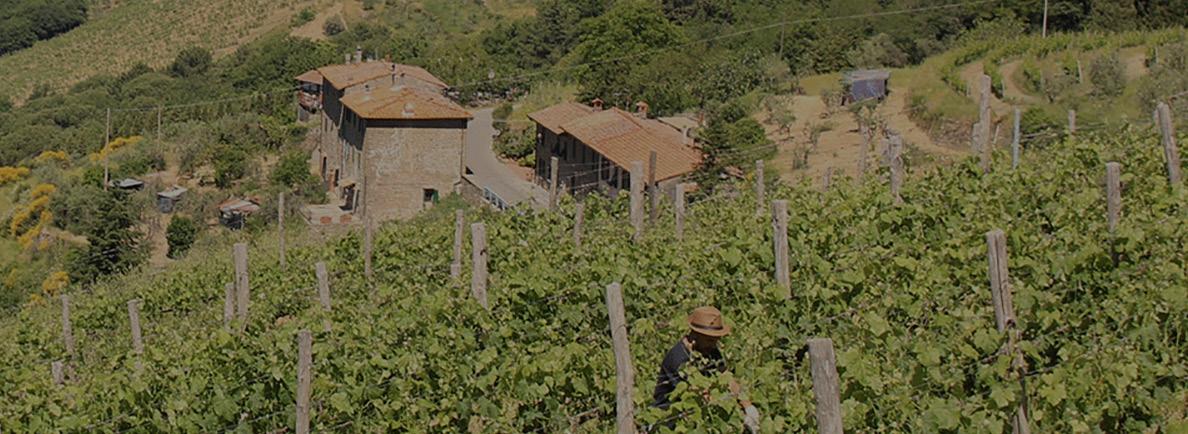
giving a hint of plumper fruit; and one cuvée of Merlot, from vines she planted before 2000 when she reinvigorated her ancient family fields and terraces of vines. Lamole Chianti Classico, 100% Sangiovese Grosso, comes from the highest vines up to 630 metres above sea level (which would be most of the way up our local mountain, Cader Idris). It’s aged in cement tanks for 12 months. Cement doesn’t sound very romantic, but it is the bedrock of some great wines. I find age and experience tend to cool the enthusiasm of winemakers for oak.
Terra di Lamole has the addition of 10% Canaiolo grapes from lower vineyards (at a mere 550 metres) along with some from Susanna’s oldest vines, planted around the time of her birth in the 1960s. Here there is some use of oak, a proportion spending time in 500-litre French oak barrels.
The Riserva Chianti Classico is made in 500-litre French tonneaux, the 2020 for around a year. This use of not-new oak is about giving texture to the wine and rounding the flavours.
The Grand Selection Sangiovese Grosso, from some of the oldest vines, only made in the best years, is aged in 1,500-litre Allier tonneaux for 24 months and is the ultimate representation of what those 60-year-old vines can do.

Il Doccio 2018 finishes off the tasting. It’s 100% Merlot, showing what restraint in the high hills of Lamole can produce. Delicious but not overblown.
Susanna is erudite, modest and charming and her wines reflect this. They are powerful, but not blockbusters. With the wines of I Fabbri the pleasure grows. The complexity reveals itself: the fruit is there, the acidity is there, the tannins too. It is the balance that makes these wines so good.
So back to the other table. Hospitality in Italy goes hand in hand with my work, which is wine, but it’s often the food that makes the experience so special.
I follow Susanna down another stone staircase to the kitchen below. A simple meal is ready to throw together. We break bread together, literally – crunchy croutons to scatter into the delicious potato and pumpkin soup, drizzled with a little fine olive oil.
Now we relax and the conversation can spread to how much olive oil one might use in a week (one litre for a family would be normal). Politics and the state of the world, however horrible it seems, is a more bearable topic with some simple meatballs in tomato sauce and small diced fried potatoes garnished with rosemary, and of course a glass of I Fabbri in hand.
Such an experience would make any job worthwhile. I have to say it is not always so, but this is a visit to stay in one’s memory for years. The time has flown and I am late to reach my accommodation. Susanna wraps up a slice of apple tart for me to take with me. She phones the hotel to say I am on my way and will be there in good time.
We go back out into the dark, mist and drizzle and hug like the old friends we now are. She gives me the sort of directions that are vital to get me straight to my hotel: left at the end of the track, right when you get to the bottom of the hill and right again by the pharmacy in the village. Instructions that seem so straightforward at the time, but sadly half an hour later I’m now further from my bed than when I left.
Eventually I head up and over some strange mountain (Chianti is hilly) and I arrive at the hotel. A light is on, and a little envelope is on the doorstep with my key and directions to my room. I sleep so well.
Mike who may or may not be leaving said, “You should write an Amazing Lunch about Zen Jen”. “Fuck off, Mike,” I said, “don’t tell me what to do, that’s not the way things work around here.” Mike raised his eyebrows and smiled using only his top lip – it is exactly the way things work around here.
“Anyway, Mike,” I said after I had eaten a spoonful of orangutan-friendly peanut butter which is certainly not an Amazing Lunch but doesn’t have any orangutan blood on it or in it, “I can’t write an Amazing Lunch about ZJ because we don’t eat lunch. We Zonder, Mike, we Wander and Wonder and Ponder and, you know, get a bit giddy on green, on the colour green entering our eyes from our Mindful Zenondering. And sometimes we go to shops and buy expensive Hippy Shit.”
ZJ appeared during lockdown, at the side of the temporary window barreltill, all masked up, demanding excessive amounts of Rothaus Alcohol Free and recommending books by Buddhist nuns wanging on about not thinking about anything. I read them because when someone wearing a mask tells me to do something, I do it, which caused a whole lot of problems during The Masked Times, most of which were technically legal but probably unprintable.

Phoebe Weller of Valhalla’s Goat in Glasgow has learned a lot over the years, from nuns, anyone wearing a mask, and of course Alanis Morissette
a good idea, but not via the alcohol route. Ironic, really, for a wine merchant.
“The thing about you writing an Amazing Lunch about ZJ, who doesn’t drink, is that it’s Ironic,” banged on Mike who may or may not be leaving in the way that he bangs on.
“Fuck off, Mike,” I said, to get the expletive count up. “Surely it’s more ironic that I’m writing an Amazing Lunch about someone who I’ve never had lunch with?”
Ah, the irony.
I read yon Buddhist nun’s book and liked it and tried staring at walls and did an online staring at walls class, again with ZJ because not only do I do the things people in masks tell me, I also court the small opportunities that the universe presents you.
Again, most are probably legal but more are unprintable.
The thing about Zen is that it says boozing is probably not the best way of numbing the relentless shiteness of everything, offering staring at walls and concentrating on what’s here right now instead. Not thinking and not knowing is
I’m in the ironic position of any child of the 90s – that my understanding of irony is based on Alanis Morissette. One of the great comedians – Chaplin perhaps? –noted that nothing in the song Ironic was, ironically, ironic. Rain on your wedding day? Unfortunate. Ten thousand spoons when all you need is a knife? Impossibly stupid.
It’s been a month of ironies, the best being my Famous Golden Helmet being stolen from my pannier as I attended court for the theft of my previous bike.
Ironic too that Mike who may or may not be leaving regularly does my head in with his encyclopaedic knowledge of fucking everything will tear a hole in the Goat cosmos if he does eventually leave. Who would have thought? It figures.


A new breed of brewers reclaim a maligned and misunderstood beer style
It’s going to be one of those summers, when people who don’t like sport watch football, and people who don’t like beer drink lager.
Lager finds true greatness in the robust hoppy styles of Germany and Czechia that have long taken a back seat to insipid and uninspiring sunshine beers from the Mediterranean or the Americas. Beers from hot places, the logic goes, must work best when Britain gets hotter.
British lager is having a moment, however. Notable independent breweries best known for their ale expertise are making lager, among them Kernel, Cloudwater, Verdant, Arbor and Purity.
Pillars in London and Devon’s Utopian have dedicated themselves to perfecting lager ahead of anything else.
They were founded in 2016 and 2019 respectively but the UK’s lager brewing heritage stretches back much further.
Wrexham Lager was first made in 1882 and Staffordshire-based Freedom was founded as a lager specialist in 1995.
Pillars was set up by Omar Razaq and Gavin Litton, who’ve since been joined in the business by Omar’s brothers Eamonn and Samie.
The recruitment of Mariuis Matulevicius
“Lots of people think of lager as cheap and watery. We regard it as a very delicate drink that requires precision”


as head brewer from nearby Beavertown took its brewing prowess from strength to strength, says Omar.
“Gavin and I had been at university together and spent a lot of time drinking terrible lager,” he adds. “So when we started the brewery we just thought: let’s try making good lager.
“We started in his flat, but we made such a mess that we moved to my mum’s shed.”
The business soon outgrew the shed and moved to its current home on a Walthamstow industrial estate, where it’s recently increased capacity by 80% to meet demand from London pubs and bottle shops.
It could outgrow the site soon and has ambitions to build the most sustainable brewery in London.
Pillars and other lager specialists manage to extract variety from a beer that drinkers tend to regard as one-paced.
“It’s really an umbrella for so many different styles,” says Omar. “Lots of people think of it as cheap and watery. But we regard it more as a very delicate drink that requires precision.
“If you have an off-flavour it will show up straight away, whereas in very hoppy ales they’ll be hidden behind all the complexity. That makes lager a very difficult style to produce well and consistently.”
The Pillars core range includes the 4.5% abv Hop, a dry-hopped lager that’s sold as an Indian Pale Lager, as a response to ubiquity of craft IPA. It’s been joined over time by a Pilsner at 4% and Helles at 4.8% abv.
“The Pilsner uses new world hops, so it does have a different flavour to the Czech style, even though we’ve gone for a Czechstyle water profile. Helles has traditional hops and is more of a lager purist’s drink.”
These are supplemented by half a dozen short-run specials each year, the latest of which is a New Zealand Pilsner, dryhopped with Kiwi hops to inject some tropical stone-fruit character.
There’s also Icebock, a take on the German eisbock style, that clocks in at anything from 8%-8.5% abv.
“We turn our glycol chillers as cold as they’ll go and hammer the fermenter with them – and pray that we don’t create a 2,500-litre block of ice,” says Omar.
“You can’t look inside the tank when it’s brewing, so you have to kind of hope for the best.”
He likens the effect to the reduction process when making a sauce while cooking, only making use of cold rather than heat.
“The flavours become more intense,” he says. “You take the water content out by freezing, but the flavour compounds stay in the beer to make it darker and bolder, with cocoa and chocolatey kind of flavours, which people don’t expect.
“We want to elevate all the time what people think of as lager.”
Yes, we've reached the fourth month of the feature that literally some people in the trade are talking about, without accidentally publishing the wrong grid or mangling the clues. Let's mark the occasion with a record number of entries!
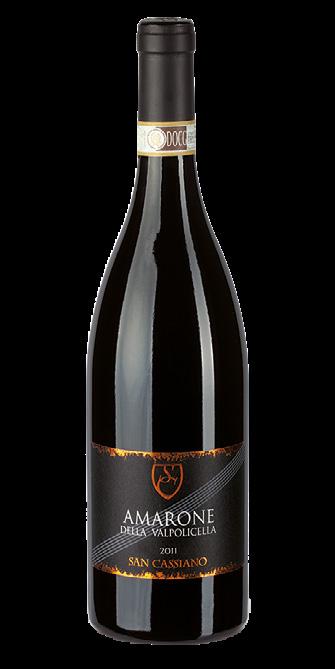
Take a photo of your completed grid and send it to claire@ winemerchantmag.com. The first correct entry drawn out of the battered beanie will win a bottle of Wine Merchant Top 100 winner San Cassiano Amarone della Valpolicella DOCG, courtesy of the generous souls at Marcato Direct
Rebecca Skeels of Marcato is a big fan. “Mirko Sella, the winemaker and owner of San Cassiano, is a master at creating velvet within these robust reds from the Valpolicella area of the Veneto,” she says.
“The environment and soil of this vineyard carries a richness which allows Mirko the choice to maintain the natural characters of the land and minimise intervention both in the vineyard and in the cellar.”
Answers to questions on page 14
1. Corpinnat
2. Dionysus
3. Petite Sirah
4. (c) Derry & Toms
5. Chianti
Crossword No 4
ACROSS
1 Beautiful (8)
5 Moves through water (5)
10 Unconventional (7)
11 Pilot (7)
12 Pollen gatherers (4)
13 When the living is easy (10)
14 Otherwise (4)
16 Artificial sparkler (10)
19 Corridor (10)
22 Yorkshireman (4)
24 Preceding wedlock (10)
25 Precious stones (4)
28 Shining (7)
29 Hollowed inward (7)
30 Bovine mammary gland (5)
31 Austrian Alpine resident (8) DOWN
1 Farewell (7)
2 Plunder (5)
3 Paradise (4)
4 Lie (7)
6 Restaurant worker (8)
7 Marriage (9)
8 Opera by Bizet (6)
9 Current of air (6)
15 Pendent (9)
17 Large island in the Channel (1,1,1)
18 Computer information store (8)
19 Thin and translucent (6)
20 Expels (6)
21 Disorder (7)
23 Oriental (7)
26 Fill with high spirits (5)
27 Untie (4)
Congratulations to Michael Walker of Vino in Edinburgh, who is the winner of the third Wine Merchant crossword.
The prize is a bottle of Château Bellevue Princesse Lieven Beaujolais, supplied by the lovely people at Hayward Brothers Runners-up all receive our very best wishes.
Solution to Crossword No 3
12-14 Denman Street London W1D 7HJ
0207 409 7276
enquiries@louislatour.co.uk www.louislatour.co.uk

@louislatouruk


hallgarten wines
Mulberry House Parkland Square 750 Capability Green Luton LU1 3LU 01582 722 538
sales@hnwines.co.uk www.hnwines.co.uk




“The 2016 harvest immortalised through the Gosset lens” Odilon de Varine – Cellar Master
We are delighted to launch Gosset Millésime 2016. The oldest wine House in Champagne, Gosset crafts vintage Champagnes that are a blend of its signature style and taste with the distinctive qualities that make a particular harvest year stand out from others.
Its latest Grand Millésime honours 2016 – an exceptional year marked by contrasted weather conditions: a cool and wet spring followed by a hot and dry late season. This is a combination of factors that have created a unique wine balancing finesse and elegance with structure and depth of fruit.
For more information, please contact sales@ louislatour.co.uk or scan the QR code.
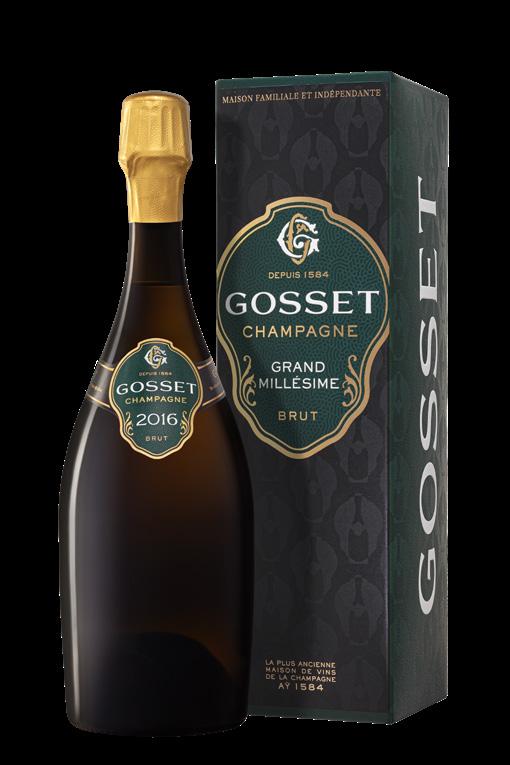

The Links, Popham Close
Hanworth
Middlesex TW13 6JE 020 8744 5550 orders@richmondwineagencies.com

@RichmondWineAG1

@richmondwineagencies

The Power of Love Chenin Blanc a wine to be proud of, a wine for pride …
June is the month of Pride
Black Elephant Vintners
The name of this Chenin Blanc, The Power of Love, came as a result of the turmoil in the world in recent years, from the Covid pandemic to the Black Lives Matter movement and gender equality issues. With a desire to improve human rights across the globe, Black Elephant Vintners is donating 5% of proceeds to two charitable organisations out.org.za and africaunite.org.za RRP£16.95
Charity donations: RWA/Ellis Wines will donate 50p per bottle sold to LGBTQ+ charity, Stonewall for any sales during June Pride month.
Black Elephant Vintners will split 5% of proceeds between two South African human rights charities.
Origin: Swartland, Western Cape, South Africa
Bottling date: 13 July 2023
ABV: 12.62%
Sustainable: Yes certified sustainable
Vegetarian and vegan: Yes
Tasting notes: The second vintage of The Power of Love Chenin Blanc sees a change of origin from Simonsberg to Swartland. It’s vibrant, full-bodied and fruit-forward with refreshing flavours of citrus, white pear, quince and lingering yellow peach.

WINE
28 Recreation Ground Road
Stamford Lincolnshire PE9 1EW 01780 755810
orders@abs.wine www.abs.wine

@ABSWines





St. James Room, 67 Pall Mall, London SW1Y 5ES 9th July • 10:30am-4pm
A first chance for the trade to taste the newly released 2023 vintage Rieslings & 2022 Pinot Noirs from our top growers including: Dr Loosen - Villa Wolf - Gunderloch Louis Guntrum - Karl H Johner - Dönnhoff - Schnaitmann Jean Stodden - Fürst - Allram
For more information or to RSVP call 01306 631155 or email lesley@abs.wine
7-9 Elliott’s Place London N1 8HX
020 7288 8888
sales@jeroboamstrade.co.uk www.jeroboamstrade.co.uk

@jeroboamstrade


hatch mansfield
New Bank House 1 Brockenhurst Road Ascot Berkshire SL5 9DL 01344 871800
info@hatch.co.uk
www.hatchmansfield.com

@hatchmansfield

Vinos Naturales Organic Orange Chardonnay Argentina

Willamette Valley Chardonnay USA




‘Pemberton’ Chardonnay Australia

KLEINE ZALZE Project Z Cabernet Sauvignon South Africa








EN LOS ANDES Pinot Noir Argentina
The Woolyard 52 Bermondsey Street
London SE1 3UD
020 7840 3600
info@mentzendorff.co.uk www.mentzendorff.co.uk


buckingham schenk
Unit 5, The E Centre
Easthampstead Road
Bracknell RG12 1NF
01753 521336
info@buckingham-schenk.co.uk www.buckingham-schenk.co.uk


@BuckSchenk
@buckinghamschenk

Nestled in the historic village of Hambledon, Hambledon Vineyard produce their wines exclusively from their own estate on the Southeast facing Newhaven Chalk slopes of Windmill Down. Discover their Chardonnay-dominant Classic and Première Cuvée which wowed the judges of the Global Masters 2024. An essential for English Wine Week and perfect for all summer occasions!




Formoreinformation,pleasecontactyourMentzendorffAccountManager

Romantic, passionate and beautiful. There are few Italian regions which can conjure up those feelings as well as the Veneto. The Amicale range endeavours to encapsulate this beauty and passion through a range of fruit driven Venetian wines, including Amicale Rosso, Rosato, Bianco and Corvina.
4 Pratt Walk, Lambeth
London SE11 6AR
0207 735 6511
www.thormanhunt.co.uk

@thormanhunt
sales@thormanhunt.co.uk

walker & Wodehouse
109a Regents Park Road
London NW1 8UR
0207 449 1665
orders@walkerwodehousewines.com www.walkerwodehousewines.com


@WalkerWodehouse


Ferrari Trento are proud to be the official sparkling wine of Formula 1 motor racing. The season is in full swing in what is the fourth year of Ferrari’s partnership with F1. With Silverstone around the corner in July, we have a special edition ‘Silverstone label’ available.
A Blanc de Blancs cuvée, it is an expression of Chardonnay from the mountainside vineyards which the Lunelli Group has made popular all over the world. Matured on its lees for 38 months, it displays great intensity on the nose. With notes of ripe fruit as well as hints of bread and hazelnuts; the wine’s flavour is inviting, thanks to its freshness and the fineness of its bubbles, with an aftertaste that combines mineral sensations with citrusy nuances.
Alongside the Silverstone label, there is also a ‘Cuvee F1 Brut NV’ and the Ferarri Brut NV ‘Celebration’ 300cl Jeroboam available, with the latter being the same bottle as the winners of the race are given to celebrate with on the podium – perfect to enjoy right up until the season ends in Abu Dhabi in December.
Please contact your Account Manager with your requirements and for any further information required.

Fells House, Station Road
Kings Langley WD4 8LH
01442 870 900
For more details about these wines and other wines from our awardwinning portfolio from some of the world’s leading wine producing families contact:
info@fells.co.uk www.fells.co.uk

@FellsWine

je_fells



‘La




Showcasing exceptional wines from the best cool-climate regions across California and Oregon since 1979.

delibo wines
The Old Pigsty, Rose Cottage Church Hanborough OX29 8AA 01993 886644
orders@delibo.co.uk
www.delibo.co.uk


The computer system for drinks trade wholesalers and importers
16 Station Road Chesham HP5 1DH
sales@vintner.co.uk www.vintner.co.uk


Rip up the rulebook with Mosel’s finest, S. A. Prüm, and rock some Riesling in July
The Rieslings from S. A. Prüm are not just for July (31 Days of Riesling). Why not give them a go, you will never look back and you may well say: “Why did I not do this before?”
S. A. Prüm is now under the stewardship of first lady of Mosel Riesling and owner of the iconic Sonnenuhr [sundial] Saskia Prüm, who took over the reins of the family winery in Wehlen in 2017.
We have the great honour to present some of the world’s most spellbinding Rieslings, from the Solitär and Essence at £14 RRP to the breathtaking GGs, Kabinetts and Ausleses. These are life-changing wines; there is a Riesling to fit any budget and style.
Why not use the 31 Days of Riesling Campaign (details at winesofgermany.co.uk) to re-energise your Riesling selection? Give us a call at Delibo and see what you have been missing and ride the Riesling wave!




020 7720 5350
order@libertywines.co.uk www.libertywines.co.uk


@liberty_wines


top selection
23 Cellini Street London SW8 2LF
www.topselection.co.uk info@topselection.co.uk
Contact: Alastair Moss
Telephone: 020 3958 0744


@topselectionwines
@tswine

Charles Heidsieck has unveiled a fitting new white label for its Blanc de Blancs NonVintage, while the Champagne inside remains the same precise selection of 15 ‘crus’ of Chardonnay spanning the Côte des Blancs (Oger, Vertus), Montagne de Reims (VillersMarmery, Trépail) and the special cru of Montgueux in the northern part of the Aube, blended with 30% reserve wines with an average age of five years.
For cellarmaster Elise Losfelt, the Blanc de Blancs NV “successfully brings together two exact opposites: the tautness and the freshness of young Chardonnays, combined with Charles’ usual silky generosity.” Perfect as an apéritif or served with seafood, this is a creamier style, aged for 3-4 years in Charles Heidsieck’s chalk cellars to achieve the signature Charles texture, depth and complexity. It is available with gift box and in magnum.
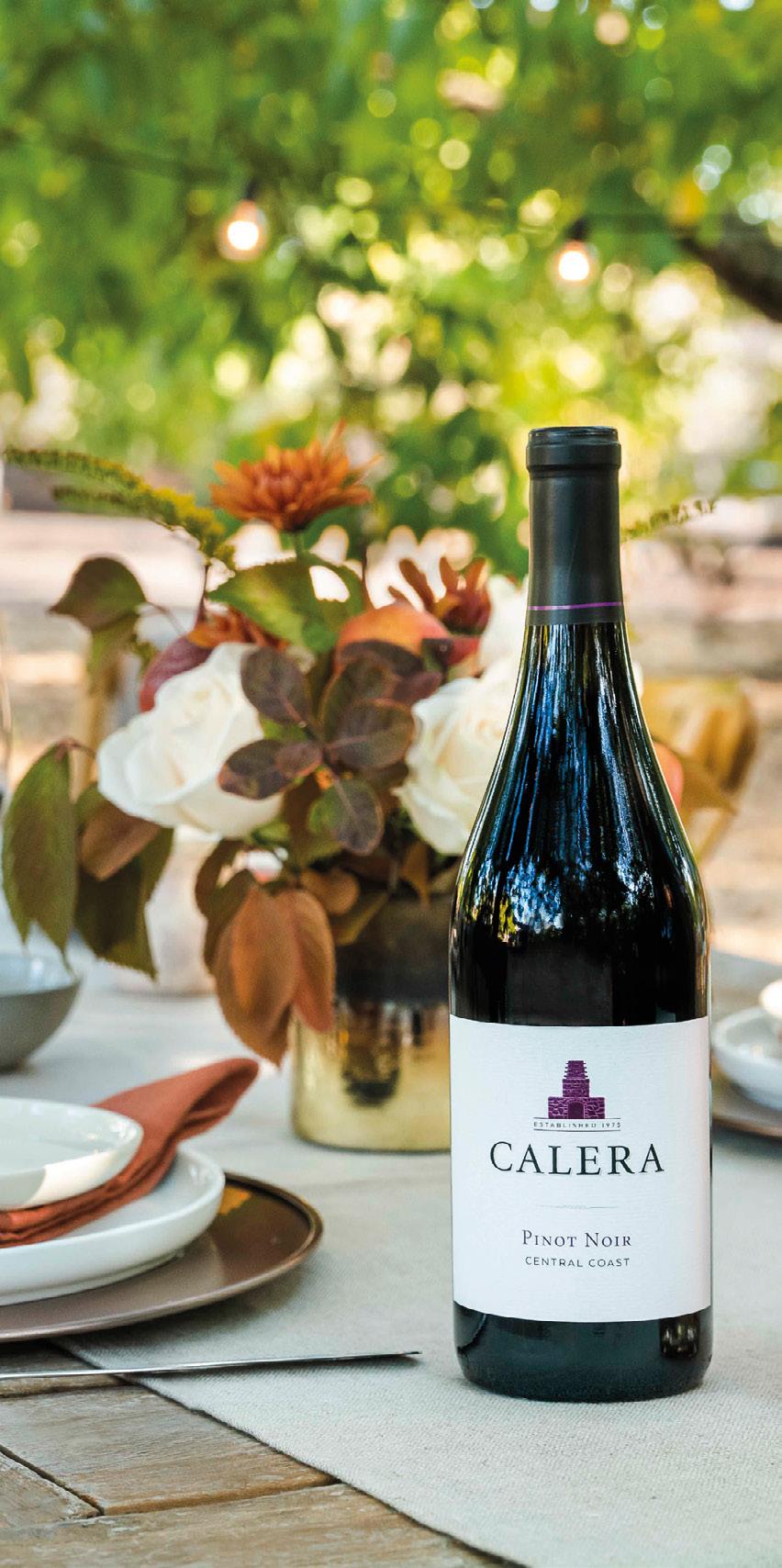
This Blanc de Blancs NV launched in 2018; however, Charles Heidsieck was one of the very first Champagne houses to demonstrate its passion for Chardonnay, producing a Blanc de Blancs in its 1949 vintage and a non-vintage Chardonnay during the 1960s. There is also evidence of a

In 1975, legendary vintner and pioneer Josh Jensen founded Calera (Spanish for “lime kiln”) high in the Gavilan Mountains of California’s majestic Central Coast. In the four decades since, Calera has helped establish the Central Coast as one of the New World’s most exciting wine regions, while earning acclaim as one of California’s iconic wineries. Crafted using grapes from a handful of the nest vineyards on the Central Coast, this alluring wine o ers enticing aromatics, soft, velvety tannins and vibrant fruit and spice. is Pinot Noir is nuanced and complex with a long, lush nish, making it a benchmark for the region.
“Late nights, curries and poverty forced me to give up professional sax playing”

Chris Davies began his drinks trade career as a key account manager with Matthew Clark in 2001. He joined Constellation Europe as a national account manager in 2004 before moving to Les Grands Chais de France in 2007, where he has been sales director for ontrade and independents since 2011.
What’s the first wine you remember drinking?
In 1985 I went on a coach holiday to the south of France with my mates for three weeks and, as you did back in the day, we lived on demijohns of dubious “wines” from the local farm. Pretty sure they were all non-varietal but boy did they make for good times.
What job would you be doing if you
weren’t in the wine trade?
My other great passion is music and I’m a saxophonist in my spare time. I’m currently in five bands, ranging from a sax quartet and a big band through to a techno marching band, Kilne. You can check them out on YouTube.
How do you relax?
For me it’s playing my saxes. For a spell in my 20s, playing was all I did. Lots of bands, recordings, tours and even a cruise but by my 30s the late nights, curries and poverty forced me to grow up. So now I choose what I want to do, but still get a buzz from practising and nailing tricky passages.
What’s the best book you’ve read recently?
It’s got to be entertaining, so I’m currently
halfway through the Jack Reacher series.
Give us a Netflix recommendation. I can safely say any film Robert De Niro has starred in. From Once Upon a Time in America to one of his latest, The Irishman For a giggle, get through the first three episodes of Still Game to understand the characters and you’ll always have something daft to watch again and again.
Do you have any sporting loyalties?
Welsh rugby team and rugby union as a whole.
Who’s your favourite music artist?
Wow. Impossible to answer and, like wine, there’s music for every emotion, time and place.
Any superstitions?
Not particularly but I wouldn’t walk under a ladder in case I got covered in paint.
Who’s your favourite wine critic?
Customers make for the best critics because they always tell you the truth.
What’s your most treasured possession? My daughter.
What’s your proudest moment?
Walking on the stage at Glastonbury as the first-ever tribute band to play there. It was 2000 with Nearly Dan (a Steely Dan tribute). I married one of the backing singers three years later.
What’s your biggest regret?
Not paying attention to French lessons in school – it would have been very handy! Instead I’m now at the mercy of Duolingo’s critical expressions and comments.
Who’s your hero?
No one individual but if I had to name a collective it would be everyone that works in healthcare. From A&E right through to looking after our parents in their homes.
Any hidden talents?
Brilliant at accents.
What’s your favourite place in the UK?
Everywhere there is a distinct lack of humans. West Wales and Scotland feature highly.
If we could grant you one wish … No duty reforms.
